






The graduate student government was initially suspended in March over BDS legislation
BY RIVERS STOUT campus@theaggie.org
!e UC Davis Law Student Association (LSA) has been reinstated, with the university lifting their March suspension of the student government over its passing of a constitutional amendment that would have enforced Boycott, Divestment, Sanctions (BDS) rules on student groups requesting funding from the LSA. The amendment, which was never officially implemented, was found by university officials to have violated restrictions on student governments to make decisions on a “viewpointneutral basis.”
While the LSA appealed the amendment on April 19, the university did not con rm that they would be reinstated until late summer.
!e end of the suspension returns control of LSA funds to students and creates a noncommittal Ethical Spending Committee.
The suspension of LSA, which represents over 660 students, upset many in the King Hall community and was the subject of several protests and criticism. !e LSA did not provide a comment on their reinstatement by the time of publication.
In a statement addressing the matter, a university spokesperson told !e California Aggie that UC Davis respects student groups’ right to free speech, but it stands rm in enforcing its funding and boycott rules.
!e decision [to reinstate the LSA] followed the vote by LSA to repeal a measure that violated University of California policy,” the university spokesperson said

via email. “[That policy] requires student governments to provide nancial and other tangible support for student activities and organizations on a viewpoint-neutral basis. !is policy prohibits nancial boycotts of entities associated with a particular country.”
“Members of the campus community may peacefully exercise their constitutional right of free
expression,” the spokesperson said. “Yet the university cannot allow disregard or violation of state or federal law and university policy. UC Davis is committed to providing an environment free of discrimination, harassment, antisemitism and other forms of hate.”
!e LSA’s new Ethical Spending Committee’s framework is still being
Davis commission emphasizes community input as it begins new year of work
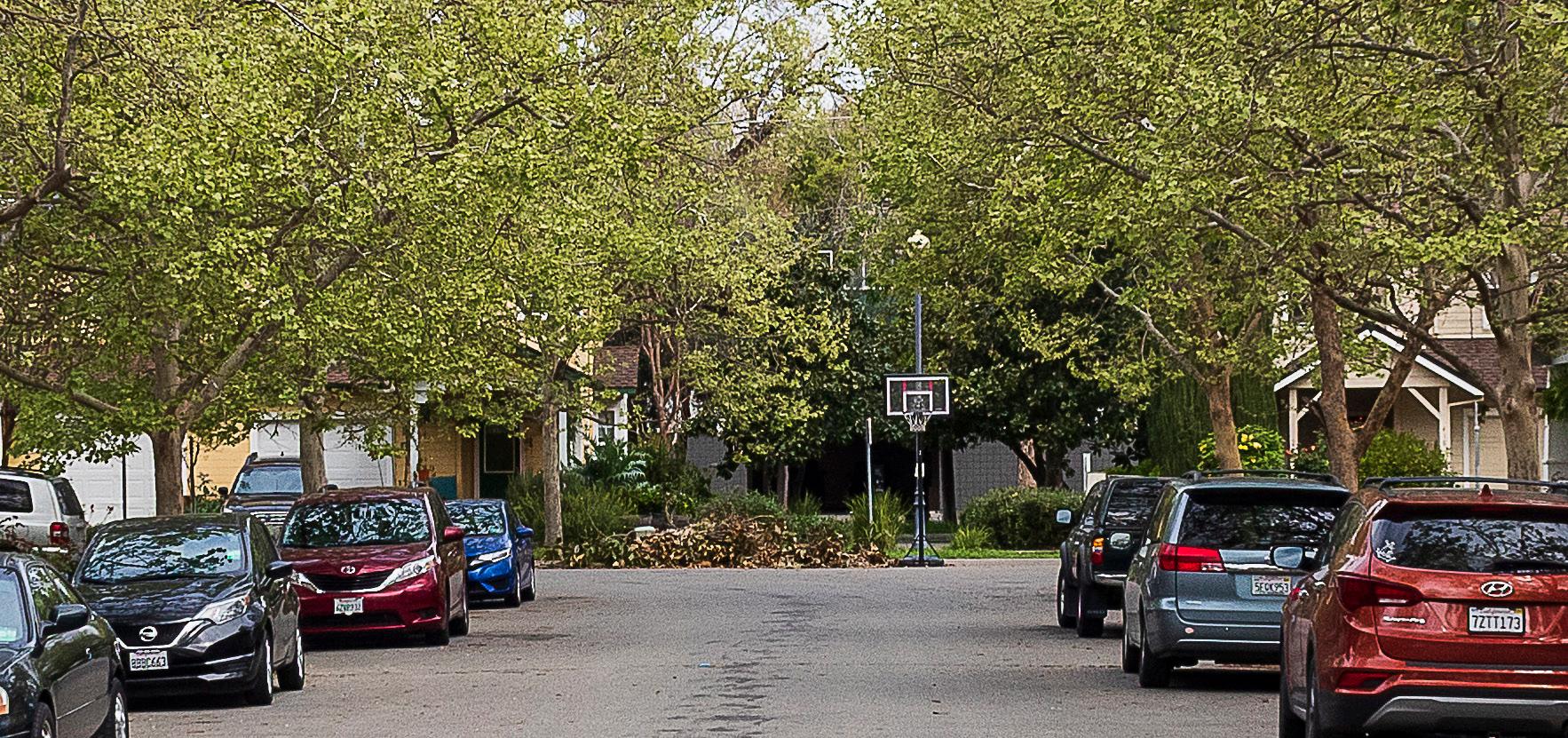
gatherings. (Aggie File)
BY ALMA
!e city of Davis, UC Davis and the Associated Students of UC Davis (ASUCD) invited community members to come together for the 19th Annual Davis Neighbors’ Night Out (DNNO) on Sunday, Oct. 5, 2025. !e event, which has become a Davis tradition, aimed to strengthen connections among residents, students and local organizations through neighborhood gatherings across the city, according to the city of Davis’ website.
First launched to build stronger community ties, DNNO encourages neighbors, students and city leaders to meet in a casual setting. !e event is held each October to include new and returning UC Davis students in neighborhood festivities, fostering relationships between long-term residents and the campus community.
Last year, more than 100 neighborhood events took place, ranging from potlucks and picnics to block parties. !is year, hosts were again encouraged to organize small gatherings in their neighborhoods, apartment complexes or community associations. !ose who registered to host were entered into a lottery for special guest visits from Davis City Council members, UC Davis mascots and Davis Police and Fire ghters.
Registration for this year’s event opened on Aug. 19. Residents were provided with a city event map to see the planned events in their areas.
One of the organizations who brought DNNO to life this year was
KDRT 95.7 FM, Davis’ community radio station. Autumn Labbe-Renault, the executive director of KDRT media access, explained the group’s involvement and role in the event.
“KDRT is a project of [the] community media center Davis Media Access (DMA),” Labbe-Renault said. “DMA frequently partners with the city, other non-pro ts and community organizations to help amplify events and causes.”
Labbe-Renault further explained the collaboration involved for this event.
“Working with the city’s Promotions Director Carrie Dyer, we produced a two-and-a-half-hour live show, aired on KDRT 95.7 FM and streamed at KDRT.org that included party music and live giveaways of gift cards provided by the city,” LabbeRenault said.
Leading up to the event, KDRT also helped spread the word. LabbeRenault shared the outreach strategies they used to inform community members.
“We promoted by newsletter, onair [public service announcements] PSAs, website and social media,” Labbe-Renault said. “Carrie and two neighborhood hosts also guested on KDRT’s show ‘Listening Lyrics.’”
For KDRT, the partnership re#ects the station’s mission to connect people through local media.
“DMA uses media tools and technology to build community,” Labbe-Renault said. “We’ve partnered with the city on this event for several years. It helps amplify the events, provide parties with a lively soundtrack
“I know in our neighborhood it’s been an important way to welcome students and build community.”
Autumn Labbe-Renault Executive Director of KDRT Media
and it’s fun.”
She added that DNNO plays an important role in bringing residents together.
“I know in our neighborhood it’s been an important way to welcome students and build community,” Labbe-Renault said. “(I) loved that some of the callers were longtime KDRT listeners and supporters, and that another caller was happy because he’d never won anything [before]!”
Over the years, KDRT’s involvement in DNNO has evolved alongside the event itself.
“We’ve gotten video some years, done live radio others,” Labbe-Renault said. “I think most people feel safer and happier when they’re known — not just ‘the folks who live down the block,’ but Bill, Carol and their dog Scout.
Neighborhoods are critical building blocks in a community, and Davis takes that seriously.”
been ignored by the regents,” Sulur said to !e Aggie in July. !e dissolution of the LSA is another part of that. It shows an increasingly drawn line between what the UC [administration] prioritised versus what students prioritise.”
In July, then-UC President Michael Drake wrote a letter to system chancellors reinforcing university policy which forbids student governments from boycotts targeted at countries. \ !is came after multiple student governments across the UC system passed legislation supporting a boycott of companies connected to Israel, whom they levy as the perpetuator of the Gaza genocide.
While the Associated Students of UC Davis (ASUCD) passed similar boycott legislation with Senate Bill #52 in 2024, it was never fully implemented as intended. The ASUCD Ethical Spending Committee created by the undergraduate student government is currently an advisory committee, a decision made by student leaders in consultation with university o cials.
designed, but LSA Representative Shasun Sulur noted that the university’s actions have created an uneasy relationship between itself and the student government.
“[!e LSA’s suspension] has been a reflection of how student rights more broadly have been treated for the past two years, as many UC student movements’ demands have
Overall, it would appear the landmark achievements reached by the ASUCD and LSA with their legislation aimed at boycotting the genocidal Israeli state have had little permanent e ect. !e results of both attempts at ethical spending legislation in recent years, and the university’s successes in nullifying these e orts, brings into question the ability of student governments and university-a liated student groups to levy their own activism in the face of o cial UC policy.
UPTE and AFSCME 3299 allege unfair labor practices, with one union having authorized a strike vote
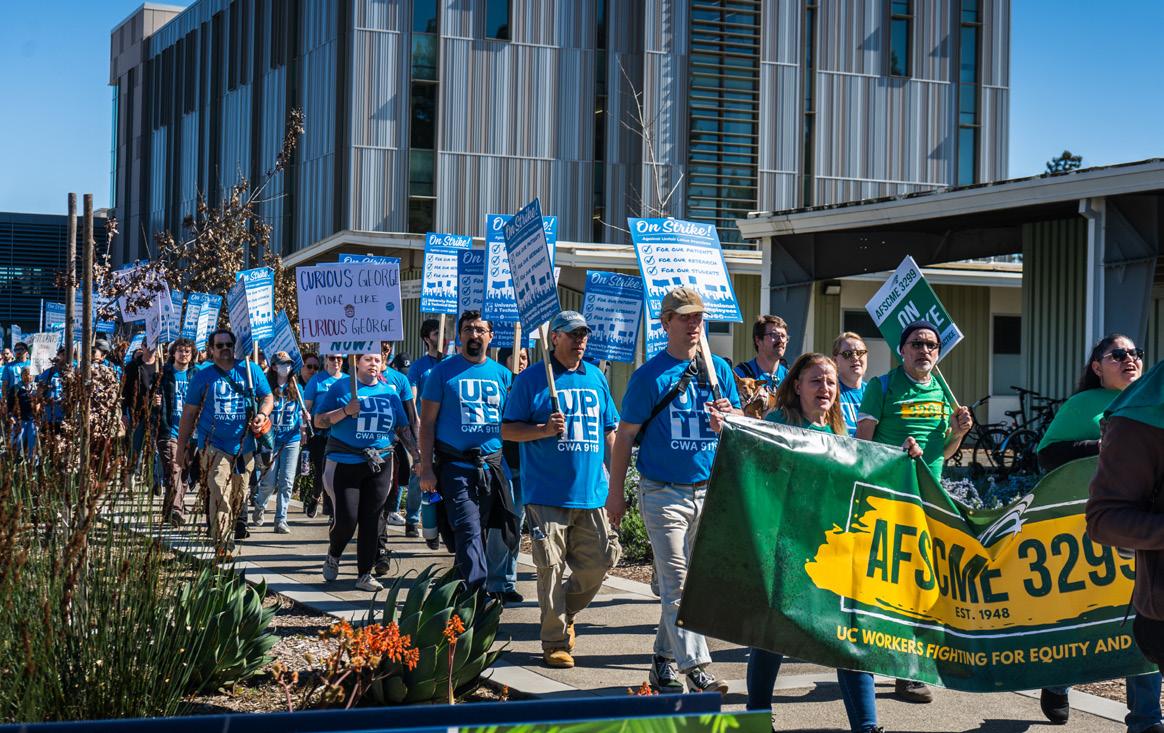
BY KHADEEJAH KHAN campus@theaggie.org
As the school year begins, three major labor unions in the University of California (UC) system are still navigating contracts and negotiations. During the 2024-25 school year, American Federation of State, County and Municipal Employees (AFSCME) Local 3299 and University Professional and Technical Employees (UPTE) Communications Workers of America (CWA) 9119 went on a series of four strikes alleging unfair labor practices. In late summer, a third union, the Research and Public Service Professionals –United Auto Workers (RPSP-UAW), formed to represent research and public service professionals.
!e California Aggie talked to UC leaders from these three unions to gain an understanding about the state of negotiations and labor actions moving forward.
UPTE-CWA 9119
!e UPTE represents over 19,000 medical, technical and research workers throughout the UC system. The union’s top priority is addressing the “real sta ng crisis at the university,” according to Amy Fletcher, a chair of UPTE’s UC Davis chapter and state union treasurer.
UPTE has engaged in a series of conversations with the UC since their last strike in May. !e UC has sent its Last, Best and Final O er (LBFO) that addresses bene ts, wages and healthcare, according to Heather Hansen, a spokesperson for the UC O ce of the President. However, Fletcher maintains that the o er failed to address union demands and that the UC is bargaining in “bad-faith.”
!e union has authorized a strike, following a vote that took place from Sept. 22 through Oct. 2, but has yet to announce strike dates.
“Even though we don’t want to necessarily go on strike, we don’t want to walk away from our research, our patients — we will call a strike, if necessary, and our members are willing to strike if needed,” Fletcher said. Other union priorities include compensation, turnover and career progression for workers. Fletcher adds that union priorities are also student priorities, with students experiencing the impact of sta shortages.
“Our students are already feeling these impacts,” Fletcher said. “We certainly don’t want to strike, but we are striking because our students are feeling the impacts of the sta ng crisis.” AFSCME 3299 The AFSCME 3299 represents more than 37,000 service, patient care and skilled craft workers. Like UPTE, their most recent strike was held on May 1 of this year, and they aimed to address issues regarding a ordability, unfair labor practices and job security.
“We are the university’s lowest-paid workers,” Dara Streit, a communications associate at AFSCME 3299, said.
“We’re living paycheck to paycheck, and the university’s current o er will keep us there. UC refuses to address the harm of rampant in#ation on our wages. It wants to get rid of our caps on healthcare increases it can implement on us, a bene t we’ve fought hard for. !ey don’t care if we’re forced to do the work of two people, and they won’t pay us like it either.”
The Senate also heard presentations, including from UPTE, at their
BY AALIYAH ESPAÑOL-RIVAS campus@aggie.org
The ASUCD Senate filled two interim senator positions, on Oct. 9, after they were vacated outside of the scheduled election cycle. Livreet Sandhu, a third-year political science major and transfer student, and Shaina Taebi, a secondyear political science and philosophy double major, were con#rmed as interim senators to serve for the rest of fall quarter.
Sandhu and Taebi take the seats of former Senators Zack Dollins, a second-year political science major, who was elected to be vice president of the External A airs Commission in spring with a quarter remaining in his term, and Solana Rodriguez, who transferred to UC Berkeley at the start of the academic year.
The second open seat was unexpected, with ASUCD Internal Vice President Dhilena Wickramasinghe explaining the second vacancy due to Rodriguez’s transfer.
“Last week we did interim interviews under the understanding that we were only #lling one vacancy,” Wickramasinghe said. “But I just got con#rmation about one of our senators from last year who transferred to a new school, which is why there were suddenly two vacancies.”
Wickramasinghe did not name Rodriguez, though the latter con#rmed her transfer to e California Aggie after the meeting.
Emergency Legislation
Also at the Oct. 9 meeting, Senate Resolution (SR) #2 was introduced as emergency legislation to endorse the signing of California’s Senate Bill 509, which aims to equip law enforcement with the tools to handle transnational repression targeting the Sikh community in the state. Transnational repression occurs when foreign governments attempt to harass or intimidate those in the United States for their political beliefs.
Written by State Senator Anna Caballero, the bill awaits signature from California Governor Gavin Newsom.
“All Californians deserve to feel safe in their homes, workplaces, and neighborhoods,” Caballero said in a press release. “Just as law enforcement is trained to identify domestic violence
and human tra$cking, they must also be prepared to protect communities targeted by foreign governments.
SB 509 is about justice, dignity, and ensuring that no one in California lives in fear because of who they are or where they come from.”
Authored by ASUCD External Affairs Commission (EAC) Chair
Simrit Singh and introduced by her commission, ASUCD SR#2 was nearly passed unanimously before Controller Trinity Chow made a comment regarding the swiftness of the procedure.
“I don’t know if people are actually taking their time to look through all the links in this document,” Chow said.
“I think it’s really great that [Singh] started really early last week and [has] already written a Senate Resolution. You should really be proud of yourself, but I just want to make sure people have had the time to mull this over and think about what this actually means. Not just have a stance of ‘What is this piece of paper I’m signing?’ but also ‘How are we as a Senate better because of it?’ In general, every piece of legislation that comes across us should be taken with great pride.”
Following this, multiple members of the Senate table expressed their support for the resolution.
International Student Representative (ISR) Robi Castaneda, highlighted the time sensitivity of the legislation and urged for the passing.
“I just want to voice my support for the resolution because of the timing, as there is a current deadline for Governor Gavin Newsom to sign it by Oct. 12,” Castaneda said. “I understand there are a lot of links that people might not have been able to look at yet, but overall, from what I’ve seen about this resolution, it’s something the [ASUCD] Senate should support, and there’s a lot of bene#t not only for UC Davis students, but also California as a whole.”
Senator Nanki Kaur also cited the prevalence of transnational repression on campus.
“[On] the topic of transnational repression — being a part of the Sikh community on campus and advocacy groups, this is a big issue our communities face,” Kaur said.
Senator Harshpartap Dhillon also voiced support for the resolution.
“No matter how much in%uence this resolution yields, I believe that it
is very crucial for the Senate not to just be evasive [and have] passive neutrality,” Dhillon said. “We need to take a stand on the things we claim to project, which is the very liberty of our students and as a larger country, the liberty of our states.”
The resolution then passed unanimously.
California Senate Bill 109, however, was not signed by the Governor, with Newsom electing to return the bill to the State Senate on Oct. 13, stating that he thought the issue would be best handled “in coordination with federal agencies.”
Presentations
The Senate also heard presentations from various student units and organizations, including from the University Professional and Technical Employees - Communications Workers of America 9119 (UPTE-CWA 9119).
UPTE member Charl Mattenson, a fourth-year psychology and political science double major, presented about ongoing union e orts for better negotiations with the UC, highlighting how the Senate could support UPTE with the announcement of their upcoming strike.
“Last week, we held the strike vote where more than 10,000 UPTE members voted, with 97% in favor of authorizing a week or longer strike,” Mattenson said. “I would love to work on [an ASUCD] resolution, because typically when resolutions are passed, the media reports on it. But more importantly, the administration pays attention.”
UPTE-CWA, which represents UC Davis professional and technical employees, previously hosted a three-day strike in early February 2025, with the American Federation of State, County and Municipal Employees Local 3299 (AFSCME 3299) to protest against alleged unfair labor practices.
Other Con rmations
Caleb Swaby-Pierce, a second-year economics major, was con#rmed as the vice chairperson for the External A airs Commission. Additionally, Nitika Sathiya, a second-year civil engineering major, was con#rmed as the chair of the Student Sustainability Career Fair Committee. Aiana Kapur, a fourthyear environmental policy analysis and planning and managerial economics double major, was con#rmed as their vice chair.
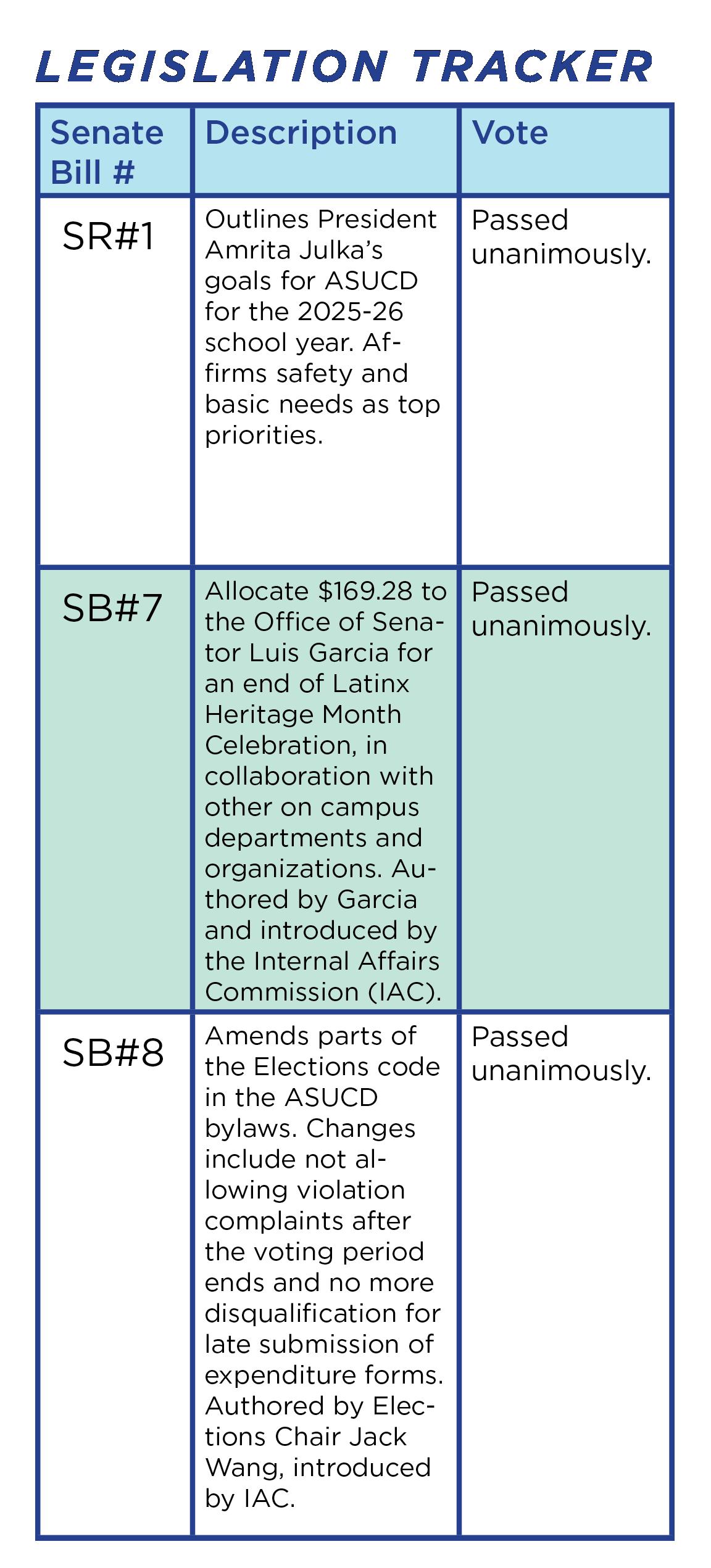
Council members discussed affordable housing and clean energy proposals
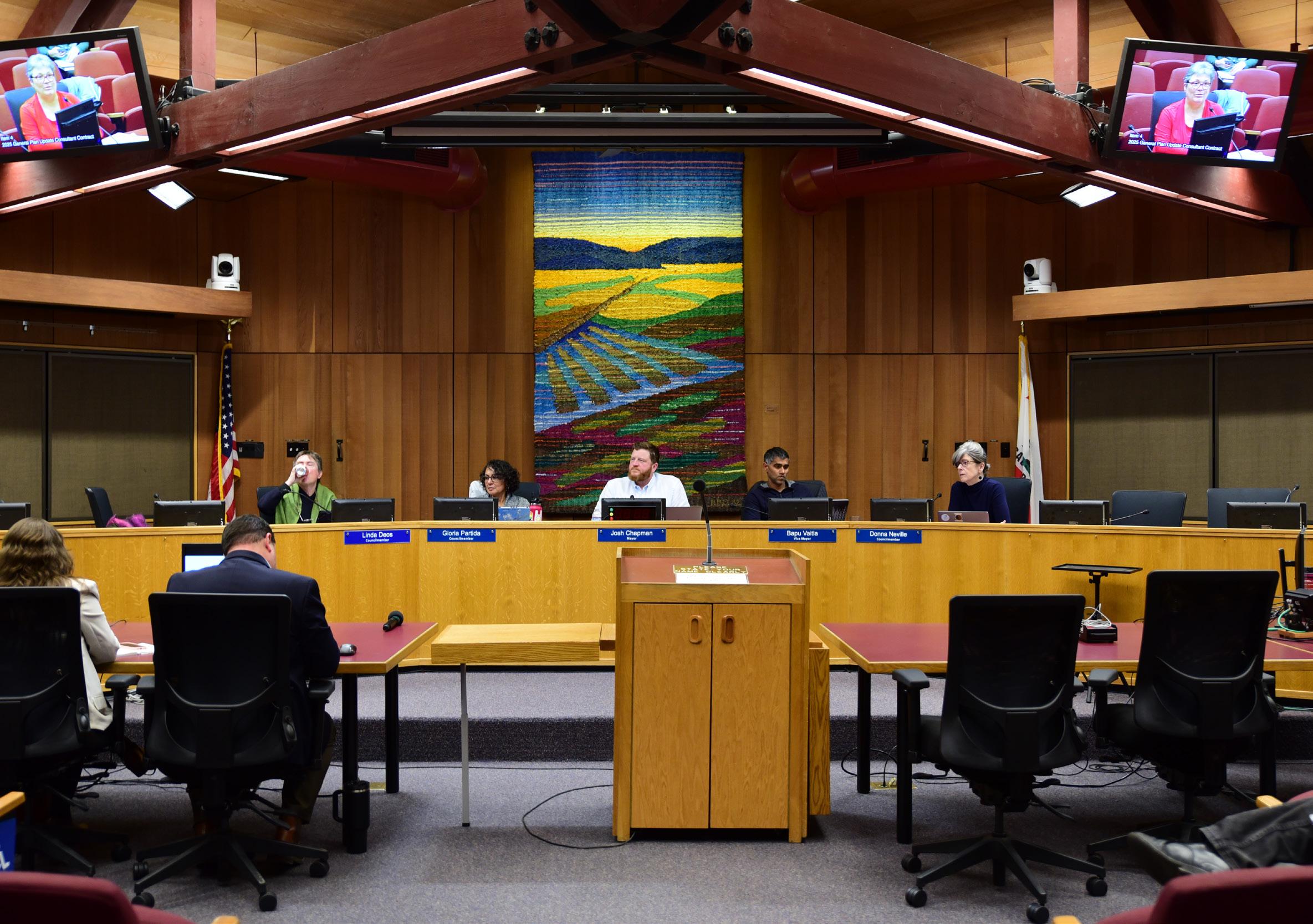
BY KATYA OKS city@theaggie.org
On Sept. 30, Davis City Council met to discuss policy considerations in relation to affordable housing developments and clean energy proposals throughout the city.
Community Development Director, Sherri Metzker, started o with a sta presentation. ere were two topics of discussion for the meeting: funding options for a ordable housing as well as climate and energy use and production. For the first topic, Metzker highlighted that development projects and necessary improvements are not included in the current #nancial plan for the city. Metzker then provided three alternative
“Davis is in desperate need of additional housing, and this development offers a thoughtful proposal that stays true to Davis community values.”
development offers a thoughtful proposal that stays true to Davis community values,” Dooley-Hedrick said. “The public must have the opportunity to vote on this matter in June of 2026.”
For the second topic of discussion, the council highlighted the importance of investing in renewable energy programs in the city. e solution included a development
of a microgrid program, which is a selfsu$cient energy system that serves a discrete geographic footprint, according to Microgrid Knowledge. e presentation shared that, in partnership with Valley Clean Energy, the city can begin to create a plan to “establish community microgrids and community battery storage cooperatives.”
e sta also recommended three options, but supported the #rst idea: which would include deferring the microgrid concept until the general plan is completed and not vesting any rights regarding the microgrid in the development agreement.
Davis Mayor Bapu Vaitla, expressed what the focus of the meeting’s discussion on the climate resilience topic should be.
“I frankly think that from a #nancial perspective — requiring a full microgrid for all units on both developments — is just not feasible,” Vaitla said. “I would rather think about a discussion that focuses on giving some direction to sta about how we, as a council, are thinking about climate resilience in respect to these developments.”
The meeting then opened to a public comment.
Lorenzo Kristov, a community member who has lived in Davis since 1987 and served eight years on the City Utilities Commission, urged the council to not approve the sta ’s recommended energy plan. He calls the recommendation from sta “a big mistake.”
“Locally owned and operated clean, resilient energy sources are urgently needed to meet today’s climate volatility, affordability and energy justice challenges,” Kristov said. “It’s up to cities, given our political climate, to be the leading actors for local energy concerns now. Whatever your concerns are about the cost of acting, the costs of not acting will be much greater.”
Ari Halberstadt, a community representative for Valley Clean Energy, shared his opinion on the plan.
“Davis has multiple opportunities to integrate local energy, [...] deferring action would miss the opportunity and result in avoidable burdens being needlessly placed on residents and businesses,” Halberstadt said. Halberstadt also o ered another solution.
“The city should explore the creation of a green#eld municipal utility to provide electricity,” Halberstadt said.
“It could save $36 million in transportation costs [...] [and] it can reduce emissions by 90%.”
Ultimately, the City Council did not support the options for the Climate Action plan and urged for another discussion at a later date. More updates will be available at the upcoming Oct. 21 City Council meeting.
Why the practice of smoking persists, despite health risks
BY GRACIELA TIU features@theaggie.org
One of the biggest associations with vaping and smoking cigarettes has, for years, been their negative health e ects. Despite this, many students here at UC Davis and in the United States still vape and smoke nicotine products.
Research surrounding the topic acknowledges a variety of reasons for this — for example, the impact of tobacco and e-cigarette advertising — but what reasons truly resonate with current and past nicotine users?
A current UC Davis student, who wishes to remain anonymous, detailed how smoking cigarettes can enhance social settings, beyond the common “looking cool” reason people often provide to justify smoking.
“I smoke mainly as a social activity because it’s something that can kind of bring people together and break the ice,” the student said. “I also really like how it can be an activity that gets you out of the house. For example, my friends and I will hike to the top of a mountain or drive to a spot with a cool view to smoke a cig. While vapes can be hit almost anywhere, cigs at least require leaving the house. Also, it can de nitely be a way to relax or unwind after a long day, especially if you roll your own cigarettes with loose tobacco, it can be a good way to chill.”
A common reason people vape or smoke nicotine products can be the physical feeling it brings, whether through vape avors, the head rush or buzz from the initial hit or the physical sensation of smoking or vaping itself.
Despite their possible appeal, both smoking cigarettes and vaping can lead to detrimental health e ects due to the toxic chemicals present in the smoke and vapor, nicotine’s classi cation as a highly addictive substance and many other parts of the process that can harm the body. Smoking cigarettes can cause cancer, heart disease, lung disease, type 2 diabetes and many other harmful health conditions, according to numerous health organizations.
Vaping, though different from cigarette smoking, can also cause irreversible heart and lung problems, organ damage and much more.
Another student who wishes to remain anonymous shared their
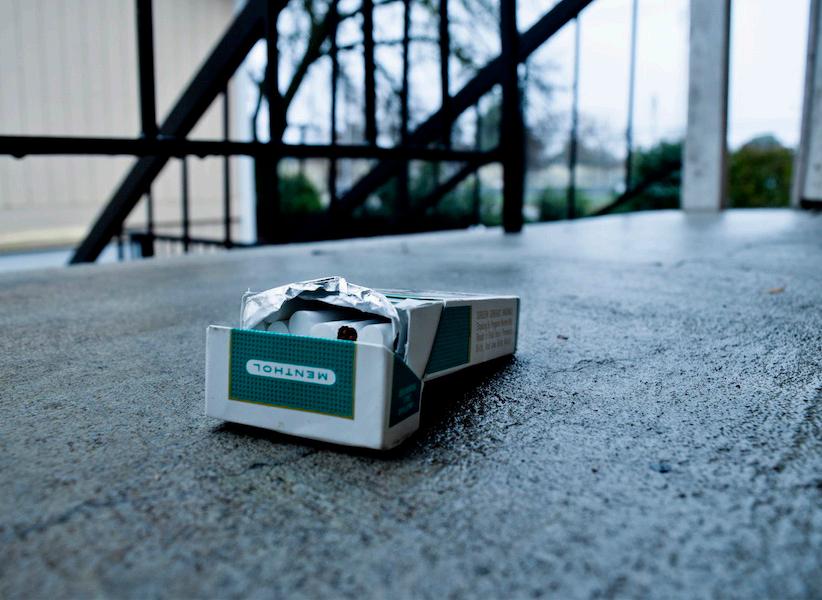
personal experience with their habit of vaping. is is coming from my experience, but I never craved the head rush,” the student said. “I craved the cool feeling of it down my throat — that sounds weird, but I swear. And I think not having that feeling is kind of hard.” e overall feeling of smoking or vaping can also bring a certain level of stress relief, according to the rst student.
“In terms of inner need, I think it ful lls di erent things depending on the occasion,” the student said. “If it’s after a stressful day, a cigarette is mostly about relaxing and unwinding.”
For many people who feel addicted to vaping, the habit itself can be hard to break.
“When I tried for the rst time, I think it was hard for me to quit because of the motion of grabbing something and being able to do it when bored or after eating, etc.,” the second student said. “It became part of my routine, so quitting felt like removing a part of my routine.” Students have also shared that an additional allure to vaping or smoking can be the excitement it brings, especially when feeling bored or having other negative feelings.
“I honestly feel like a big part of the
reason I vape is because of boredom; it’s just something to do,” a third anonymous student said. e rst student described how the process of vaping made doing di cult or unappealing tasks feel easier.
“I think vaping low-key helped me do stu that I didn’t want to do, because it was like ‘oh but I have my vape’ so I can tolerate it,” the student said.
A nal anonymous student shared their experience after quitting vaping, underlining the true change they felt in their life.
“I remember how physically painful it was when I was addicted — it would hurt to breathe,” the fourth student said.
“I don’t want to be dependent on a substance that is bad for my health, and I know staying o of it puts the minds of my loved ones at ease.”
Of the many reasons students continue vaping and smoking despite health risks, the challenge of quitting can be one of the strongest contributors. UC Davis o ers various resources to aid students who wish to quit, available through the UC Davis branch of Healthy Campus Network (HCN), Healthy UC Davis.
A look into popular Halloween traditions and UC Davis students’ favorite ways to celebrate
BY AMBER WARNKE features@theaggie.org
As Halloween is just around the corner, students are starting to participate in traditions long associated with the holiday. From buying costumes to carving pumpkins, the beginning of October denotes a segue into the spooky season. Despite the popularity of this iconic holiday, many do not know where these traditions came from, or why we still celebrate them the way we do today.
“I know [the origins of Halloween] are pagan from Samhaim, and how [practitioners] believed it was when the veil between this world and the spiritual world was the thinnest,” Nirvana Ziaie Nejad, a fourthyear English major, said.
Like Nejad explains, Halloween’s roots can be traced to the Celtic festival of Samhaim, or “summer’s end” — a Celtic harvest festival dating back at least 2,000 years. involved bon light into the dark part of the year and ensure survival through the winter by pleasing the deities. when it was believed that the veil between the mortal and spirit worlds was the most fragile, allowing spirits to enter the world of the living.
is explains the basic origins of the holiday, but many people still wonder why Halloween famously includes the tradition of dressing up in costume.
“My favorite part of Halloween is getting to dress up with friends and planning a group costume — I guess that’s also something that would be interesting to know why we do,” Sarah Lazureanu, a second-year managerial economics major, said. Costume-wearing came about as a way for people to try to frighten o beings who managed to enter our world. However, this was not the only purpose of the costumes — Samhaim also o ered an opportunity for individuals to cross-dress, granting celebrators the rare opportunity to don clothing of the
opposite sex. e chance to dress up and express oneself in different ways through costumes has been one of the most consistent aspects of the holiday throughout time. For many at UC Davis and beyond, this is their favorite
aspect of the holiday — this especially rings true for Harmony Aragon, a first-year molecular and medical microbiology major.
“In a perfect world, anyone would wear whatever they want and that would be normal, but we have speci c holidays meant for that, so that’s when
with trick-or-treating, a longstanding tradition when children go door-todoor asking for candy while in costume. ere are multiple traditions that trickor treating could have stemmed from, including the Celtic practice of leaving out food to appease spirits during Samhaim.
By the Middle Ages, “Mumming” became a tradition when people would dress up as ghosts and demons, performing and entertaining in exchange for food or drinks. Lastly, trick-or-treating may have originated from young people committing acts of vandalism and occasional violence on the holiday. In response to this, familyfriendly trick-or-treating came about as a way to give the youth a way to celebrate without delving into chaos. All these factors may have contributed to the creation of the modern trick-or-treating tradition as we know it.

Another key part of Halloween celebration is pumpkin carving, which originated as turnip carving in Ireland. According to legend, a man named Stingy Jack once trapped the Devil and only released him after making him promise to never send Jack to Hell. Instead, when Jack died and was rejected from Heaven, he wandered earth as a ghost for eternity, and the Devil gave Jack a carved out turnip with a burning coal for light. is led to turnip-carving as a way to ward o Jack’s spirit, bringing about the name “JackO-Lantern.” When the tradition was brought over to America by Irish immigrants, people began using pumpkins instead. All of these traditions have come together to create the contemporary version of Halloween that we celebrate today. While college students look forward to Halloween parties or scary movie nights, they can remember the origins of the same celebrations they continue today. When Aggies dress up, they carry out the same human desire to play around with selfpresentation, just like Celts had thousands of years ago. Ultimately, through all its traditions, Halloween is about togetherness — whether that be partying, planning costumes, carving Jack-O-Lanterns or watching scary movies. e thrill of fear we associate with the holiday is only meaningful when combined with the realization that there is nothing to be afraid of after all, as these Davis students have shared, so long as we surround ourselves with care and community.
How MAGA Christianity is being used to protect the Trump administration
/ AGGIE
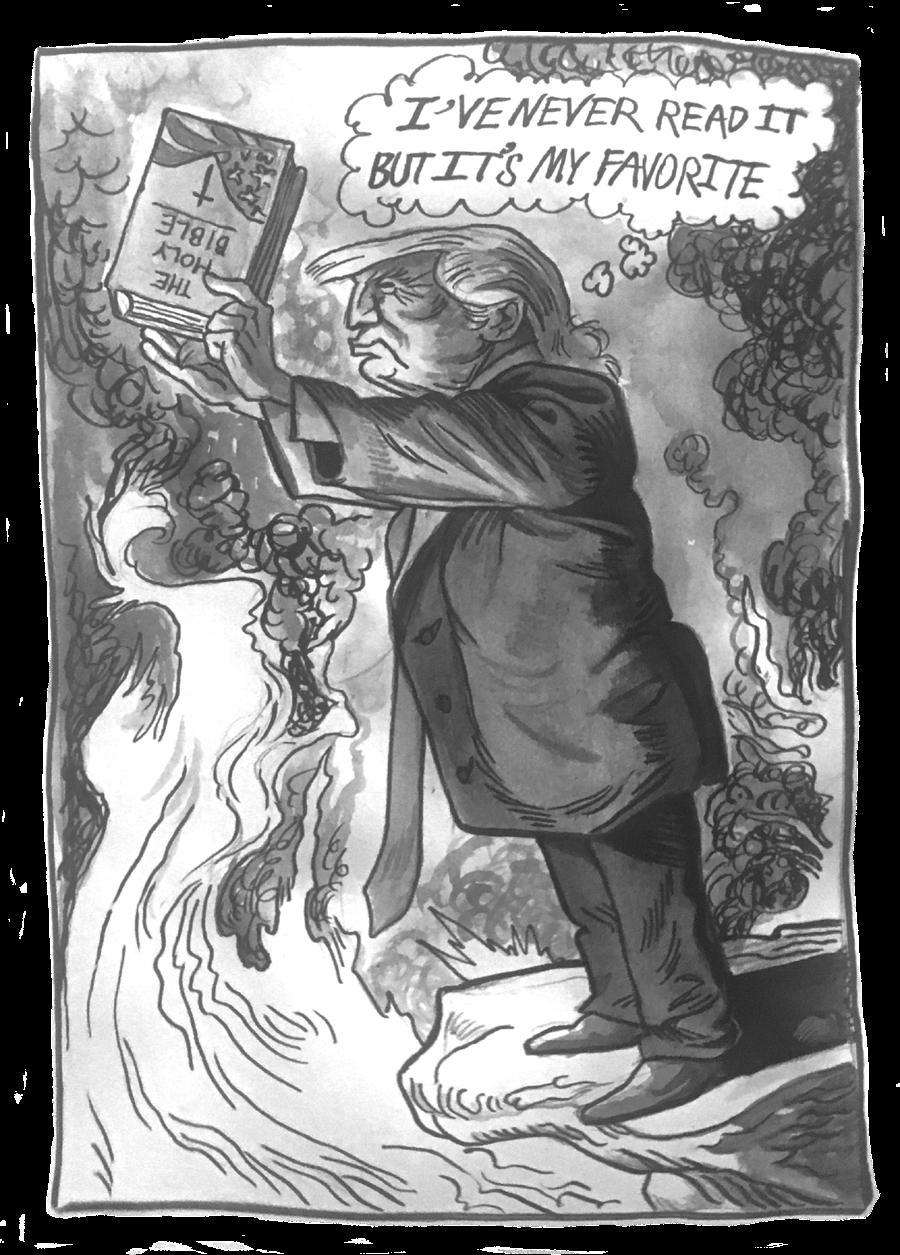
BY SABRINA FIGUEROA AVILA
sfigueroaavila@ucdavis.edu
When you grow up in the Catholic church, going to mass with medieval stained glass windows and the Virgin Mary constantly staring you down, you retain a lot of religious guilt about everything you do, especially if your actions go against the word of God. So imagine my surprise when the second Trump administration took office earlier this year, blatantly claiming a man with 34 felony convictions, an anti-immigrantion platform and sexual assault allegations to be “the second coming of Christ.” I shiver at the audacity.
In all seriousness, Christianity among supporters of the “Make America Great Again” (MAGA) movement — the slogan of Donald Trump’s political party — has been in the media spotlight since the death of Charlie Kirk. However, it’s been a topic of cultural conversation since Trump’s rst term, when he rst claimed to be “the chosen one.” His claims to be a “savior” only increased in the summer
before the 2024 Presidential Election, when he was shot in the ear at a political rally in Pennsylvania. By that point, some of his MAGA supporters saw him as a divine being, with a divine order to rule.
David French, a columnist at the New York Times, recently wrote about how MAGA evangelicals applauded Charlie Kirk’s widow Erika Kirk for her forgiveness of her husband’s murderer, while simultaneously applauding Stephen Miller, White House deputy chief of sta , and Trump’s comments on “hating your enemies.” French argues the misinterpretation of Romans 13 — a biblical passage on the role of authorities — allows MAGA to approve of forgiveness and hate at the same time.
“To look at Romans 13 as excusing Trump is to make what amounts to an astonishing category error… Scripture could not be more clear that a ruler is obligated to do justice and that the sword (to the extent it should be wielded) exists to protect the innocent, not to punish your enemies,” French’s column reads.
What global protests reveal about the state of our nation

BY NEVAEH KARRAKER
nakarraker@ucdavis.edu
Immigration is arguably the most prevalent issue in the world right now, and the unease encompassing it isn’t leaving anytime soon.
Japan, the United Kingdom, Australia, Poland and Germany are being swept deep into a wave of antiimmigration protests. Although these con icts surfaced years prior, they are now thrown into the spotlight.
In Poland, anti-immigration protests took place in more than 80 cities over the summer. In Japan, a recent in ux of tourism has fueled resentment among locals, as they battle rising housing prices and pollution. In the U.K., far-right activist Tommy Robinson led 100,000 Londoners in anti-migrant sentiment just a month ago.
While many of these protestors align with extremist factions, their concerns stem from legitimate issues about housing shortages, unemployment, economic instability and the premise that the government favors foreigners over their own citizens.
Abroad, Russia’s war in Ukraine displaced millions, with over five million Ukrainians seeking refuge in neighboring European countries like Germany and Poland. e U.K., Poland and Germany are accepting numerous more international asylum applications than their resources allow, which compounds the already critical housing shortage. Even in the United States, the “American dream” feels unreachable; the “land of opportunity” is nowhere in
These parties are no fun
Affective polarization: an affliction with insufferable symptoms
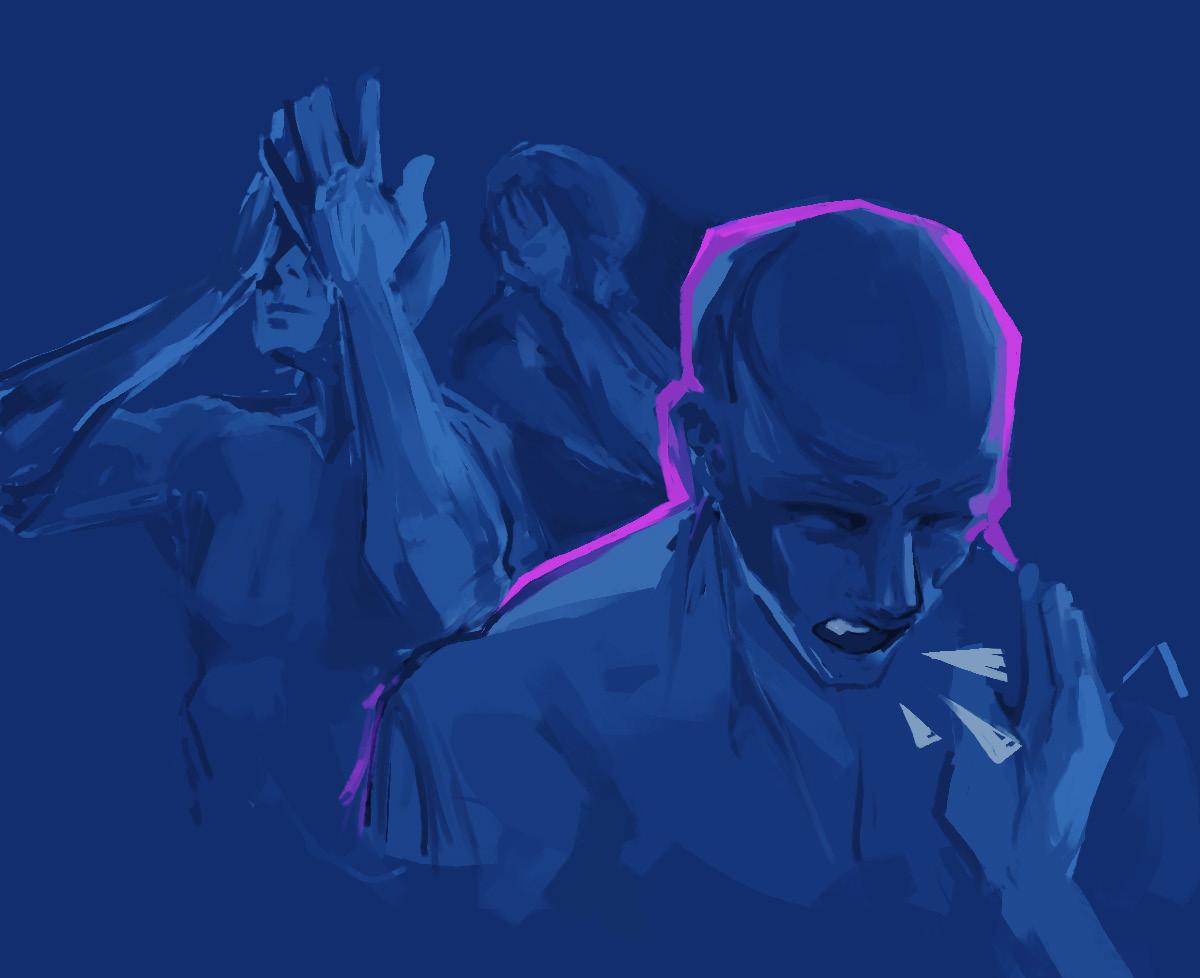
BY VIOLET ZANZOT vmzanzot@ucdavis.edu
History will have its way with the affective polarization that exists in America today. Future textbooks will have headlines that read “ e battle between the blue-haired and redcapped raged onward,” and Alligator Alcatraz will be memorialized similar to Manzanar. Much as we may have read about Ronald Reagan’s presidency and the civil rights movement, we can see plainly that we once again exist at a cultural and political in ection point — a moment in time that is producing a shift in our cultural norms.
A ective polarization — de ned as “the tendency of Democrats and Republicans to dislike and distrust one another” — has been exacerbated by extremists, who create a feedback loop to push people further apart. e masses seem to be the fuel feeding the re of the tension we’re seeing emerge between the political left and right: there is no question that there is partisan division in America today. In essence, politicians and public gures are feeding o the existing social and political turmoil to gain popularity; they rally their supporters around
collective animosity for the opposing side, tightening their allegiance to their party while decreasing their tolerance of the other.
Oftentimes, when we talk about the problems in our country today, speculatory commentary far outweighs self-re ection. How often do we look in the mirror and ask ourselves why we dislike or distrust people who think di erently? How often do we assume we are right, without even considering what it even means to be right in the rst place?
Researchers Jesse Graham, Brian Nosek and Jonathon Haidt studied the accuracy of how political liberals and conservatives stereotype one another. eir results revealed that the di erences in how people think are exaggerated relative to the actual differences.
It’s not that no di erences exist, but rather that people have moved their perceptions of the “other” farther and farther away from their perceptions of themselves. Interestingly, they found that liberals were the least accurate in their stereotyping, while conservatives were more accurate and moderates were the most accurate. But, as a whole, participants demonstrated over-in ated
in-group and out-group discrepancies. When was the last time you asked someone who disagreed with you why they think that way, especially at a moral or ethical level? As a result of media sensationalism and the tendency for benefactors of polarization to prey on people, our planes of consciousness have been separated. If we could be more compassionate about why people think the way they do, perhaps we could reach more consensus on the grounds of “why,” even if we disagree on “what.” Our goals may be similar in spite of disagreements regarding how to approach them. In the end, this is a war based on unfounded assumptions. It is not a substantiated distinction, it is a war of perception rather than material reality. Respectful politics have become old fashioned because we’ve allowed rivalry to take over. Maybe blaming the other side relieves us of any personal accountability, but this “othering” is not the smart nor the moral thing to do.
Disclaimer: e views and opinions expressed by guest contributors belong to the guest contributors alone and do not necessarily indicate the views and opinions held by e California Aggie.
sight, especially in the face of political unrest and a fragile economy. It is of paramount importance that we understand these global issues, as they indirectly force the U.S. to reconsider its own diplomatic policies. When European countries turn away asylum seekers or war refugees to ease their own domestic a airs, the U.S. is the next place they turn to. This amplifies the pressure on our overwhelmed border system and stretches our thin resources. In July 2024, the Department of Homeland Security declared that asylum centers had hit overcapacity, and, in 2023, they discussed how overloaded borders create vulnerabilities that transnational criminal organizations can exploit for drug and human tra cking.
Similarly, when countries like Japan limit tourism or foreign residency, skilled workers and students migrate to countries that have more lenient customs policies. e U.S., despite the new line of federal immigration policies under the Trump administration, remains a sought-after destination for research and employment. As these in uences put even more strain on the borders, it propagates its many existing vulnerabilities.
e U.S., similarly, has experienced its own stream of protests in recent months. In contrast to the farright demonstrations in countries overseas, pro-migrant protests and demonstrations against Immigrations and Customs Enforcement (ICE) — such as the nationwide “No Kings” protest this past June — were a response to the actions of the Trump
administration. Strict regulations on HB-1 visas have sparked tension in universities and organizations, and immigrants continue to live in fear of being one of the two million people deported by Trump’s increasingly severe policies.
Immigration is a delicate topic.
Tourism and migration both enrich culture and boost economies with skilled labor and business innovation.
To some, anti-immigration sentiments aren’t always rooted in opposition to diversity; instead, they can be a plea for the government to bring balance and structure to a dysregulated population. Expecting immigrants to uphold national laws, values and cultures in the process to gain citizenship is not always inherently xenophobic. Yet, unaddressed fears lapse into anger and become a driving force for violent or exclusionary public outrage.
At the core, people in the U.S. are facing the same dilemma as those abroad: Who should we help rst?
Should the government prioritize international citizens seeking refuge from war and homelessness, or the welfare of their own struggling people? ese rampant protests represent the ongoing skirmish between globalists and nationalists: one values open borders, equity and compassion; the other sovereignty and structure. When does caution become overprotective?
Today, immigration is extremely salient, so staying informed with foreign a airs is just as vital as with domestic ones.
IMMIGRATION on 7
How to thrive in the face of indifference
BY JACKSON IVY jjivy@ucdavis.edu
To be young in today’s world is to struggle. We struggle for calm, justice or some assurance that things are not as bad as they seem, yet so many things are stacked against us. Media reports are rarely good, and it’s too easy to reach a point where you dread the notion of even looking at your phone. is is no accident — corporations want you to feel drained, hopeless and eventually apathetic. ey want you to feel like there’s no point — that obstacles are insurmountable. at way, you’ll reach for your phone and numb yourself by scrolling. is does not make us bad or weak; all of us know that things ought to change, and every second they don’t is an injustice and a disservice to our generation. But it still feels impossible.
I believe this feeling is natural. When we look to history for inspiration on how to enact sweeping change, we see revolution, civil unrest, grassroots movement, mass mobilization — all things that feel out of place or “too far” in today’s world. But there’s one lingering question I always have: Where does resistance begin?
In the wake of a world designed to overwhelm, it’s natural to want to shut down or look the other direction. But this does not solve our discord with the problem, nor does it address the problem itself. Instead of shutting down and shutting out the chaos, I propose a strategy I’ve been practicing since I got to college. I like to think of it as a form of compartmentalization, where I can take steps toward e ective and meaningful resistance that relieves the strain of inaction and helps me approach the issue, one step at a time. is compartmentalization strategy starts with expanding the de nition of “resistance.” Resistance, as a concept, doesn’t just include protesting the injustices of the world; it includes resisting the feeling that protesting injustice is pointless.
It expands to include seeing every word, every step forward and every breath as a form of de ance. ink about it: big corporations who contribute the most to climate change, for example, want you to feel hopeless.
But if it were truly hopeless, why would we continue to see our friends, drink co ee, go to class or otherwise have fun?
It’s not meaningless, and extracting meaning from a life in which you are
“In the wake of a world designed to overwhelm, it’s natural to want to shut down or look the other direction. But this does not solve our discord with the problem, nor does it address the problem itself.”
made to feel that none exists is the very essence of de ance. Every day you thrive without the permission of power-hungry individuals is a day you win. Every time you laugh with your friends is a laugh at their expense. Every time you hug someone you love, that precious moment belongs to you forever.
Choosing to thrive in spite of how many terrible things happen every day is a constant state of victory.
Once you can build a foundation of passive resistance, it becomes easier to face the bigger things.
Once I started waking up and seeing that de ning moment where I nally got out of bed as a step toward positive change, I started feeling like it was easier to think about protest — to write, to advocate, to boycott, to revolt. I believe this happened because I could recall all the times I resisted apathy by getting up anyway, resisted repression by reading a book or resisted consumerism by falling in love.
I felt like I was getting the hang of resistance and started to think bigger.
All this abstract talk is really a means to an end — at the end of the day, tangible change is not caused by breathing without permission; rather, learning what resistance means to you, rst and foremost, is what allows us to resist together.
Disclaimer: e views and opinions expressed by guest contributors belong to the guest contributors alone and do not necessarily indicate the views and opinions held by e California Aggie.
The Editorial Board’s guide to getting through the frat flu (or any other seasonal illness you may be facing)
WRITTEN BY THE EDITORIAL BOARD
It seems to be that time of year in Davis where people all around us are succumbing to the common cold or some other virus (the members of this Editorial Board being no exception).
An unfortunate reality of the quarter system is that being taken out by sickness can result in missing out on more classwork and lectures than one may expect. With stormclouds ahead and midterms around the corner, we’ve compiled some of our go-to tips to ght o the worst of seasonal illnesses and get you back on your feet.
As always, take our advice with a grain of salt; we’re students, not medical professionals. Be sure to go to your doctor regularly and when symptoms persist.
Tips for when you are sick
This cannot be overstated, but drink water regularly and stay hydrated. Experts say that adult males should drink 15 cups of water daily and adult females should drink 11 cups. You may have to drink a little more if you are sick, depending on your symptoms. Stick to clear uids, like water, juice or broth. For boost, consider taking water with electrolyte powder or vitamins, like zinc or vitamin C.
Hot tea with honey does wonders for congestion and sore throats, but beware that not all teas are made equal. Herbal varieties are usually recommended; we like tea with turmeric, lemon echinacea and ginger. Avoid teas with ca eine, like black, green or oolong tea. Ca eine is a diuretic and can actually be dehydrating when sick. For that reason, avoid energy drinks and prioritize getting rest.
On that note, get plenty of sleep. Your body needs rest to recover e ectively and help ght o infections. If you have headaches and nausea, peppermint oil can sometimes help relieve symptoms. Sinus rinses can alleviate congestion, and gargling warm
salt water helps soothe scratchy throats. Try to communicate with classmates to stay informed on what you’ve missed in class (and o er notes in return if or when they are the ones stuck at home). Lecture capture can sometimes miss details and an in-person source of information is always helpful. Likewise, make sure to check syllabi for attendance and excused absence policies before emailing professors and teaching assistants.
Importantly, try to keep a positive mindset. No one likes being sick, but falling into doomism and despair — rather than keeping a recovery mindset — only creates extra hurdles for you to surpass. Give your body the time it needs to recover and avoid leaning into negative thoughts.
Tips for general well-being
Once you’ve recovered, there are several steps you can take to help prevent catching another virus. Daily exercise, including regular cardio, gets your heart pumping and keeps you healthier overall. Not all exercise has to be high-intensity: walking, yoga and other low-impact activities can be incredibly e ective in their own right.
Even after having lived through a global pandemic, personal hygiene seems to be lacking among many. Wash your hands thoroughly, and consider carrying hand sanitizer or wet wipes in your school bag.
Staying hydrated is a lifelong, 365-days-of-the-year goal too — carry around a reusable water bottle and re ll it often. Likewise, try to eat healthy and maintain a proper, balanced diet. Make sure to hit all the major food groups, eat enough ber and protein and avoid processed and sugary foods.
Once the storms have passed, go outside! Fresh air can help regulate the body, and connecting with nature has been linked to improvements in mood and mental health. !e Arboretum is an on-campus favorite, but there are several
popular hiking paths within driving distance from Davis, including the foothills in Auburn and trails at South Yuba River State Park. Looking out for your mental health is another way to take care of your physical wellbeing. !e two are closely linked, so be sure to avoid overexerting yourself. In this e ort, try to make time to build and maintain strong relationships with friends — prioritizing a strong social network promotes social wellbeing, which is a key element of your mental health.
A note on vaccines Some diseases seem to rapidly disappear from the general population for a simple reason: vaccines. Herd immunity is real and vaccines are safe, e ective and important. Several large retail pharmacies o er free walk-in u shots for most insurance plans.
Scan to read the rest online SEE ONLINE

Editorial Board
ALYSSA CREVOISERAT Editor-in-Chief
MAYA KORNYEYEVA Managing Editor
VINCE BASADA Campus News Editor
JORDAN POLTORAK City News Editor
MOLLY THOMPSON Opinion Editor
ZOEY MORTAZAVI Features Editor
SAVANNAH ANNO Arts & Culture Editor
MEGAN JOSEPH Sports Editor
KATIE HELLMAN Science & Tech Editor Managing Staf
JENNA LEE Photo Director
NOELLE ESCALANTE Layout Director
SAVANNAH BURGER Design Director
SAM RUIZ New Media Manager
KAYLIE HUANG Social Media Manager
JULIAN MONTANA Website Manager
JULIA CROSSAN Distribution & Outreach Director
YILAN LI Translation Director
CARMEN RODRIGUEZ-ZARATE Translation Director
JENNY DYE Copy Chief
ALYSSA PULIDO Copy Chief
LAURIE PEDERSON Business Development Manager
Enter digits from 1 to 9 into the blank spaces. Every row, column and 3x3 square must contain each digit. Each Sudoku has a unique solution that can be reached logically without guessing.
Answer to previous puzzle 10/09/25

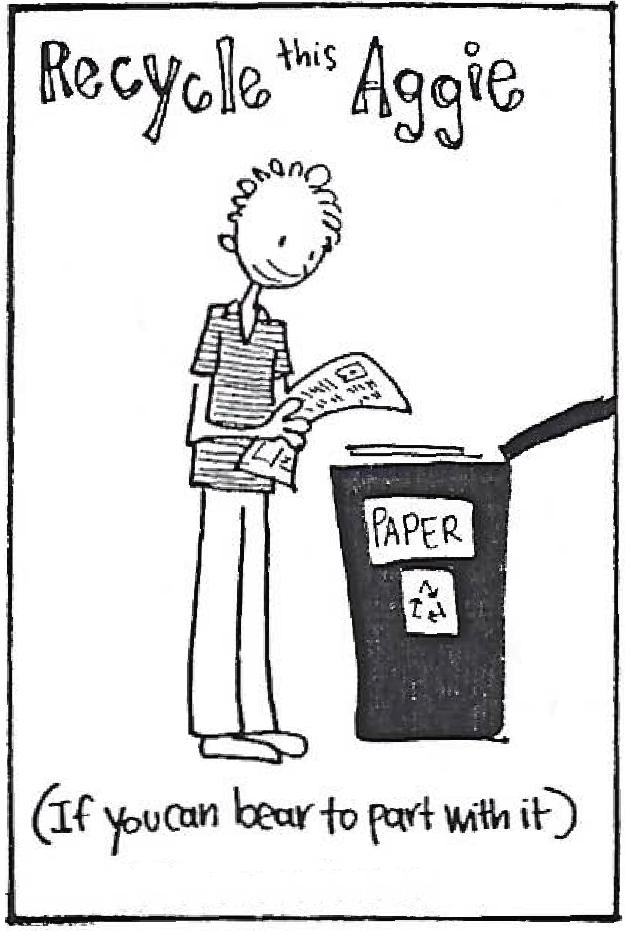


BY BELLA PETERSON
arts@theaggie.org

Song: “You’re Dead” by Norma Tanega (1966)
While we’re on the topic of “oldies but goodies,” you’d be remiss not to listen to “You’re Dead” by Norma Tanega this October. It’s a perfectly festive song for the season; while the leaves are changing their colors and everyone’s talking about their favorite pumpkin avored thing, there’s nothing more that I love than listening to a song repeat “you’re dead” over and over again. Jokes aside, this track is incredible. With haunting lyrics like, “hear the unloved weeping like rain / guard your sleep from the sound of their pain,” the song has been a staple in my annual fall playlist. I’ve always loved the storytelling quality within folk music, and “You’re Dead” is a prime example of why it’s so special to me. ough the song is often related to vampiric culture due to its presence in the show “What We Do in the Shadows,” it was originally written as a sarcastic testament to the state of struggles that came with surviving in the ‘60s New York folk scene. Whatever the intentions may have been, this song is a perfect choice to get you in the mood for all things bizarre and spooky.
TV Show: “ e Twilight Zone” by Rod Serling (1959-1964)

ere is a fth dimension beyond that which is known to man…it is the middle ground between light and shadow…it is an area which we call the Twilight Zone,” the voice of Rod Serling says at each beginning of this classic shows’ episodes. If the ominous introduction to “ e Twilight Zone” doesn’t immediately draw you in, its depictions of the supernatural most certainly will. e inspiration behind contemporary science ction television — from “Black Mirror” (2011) to “Severance” (2022) — “ e Twilight Zone” is a classic that anyone can become a fan of. e series utilizes each episode to depict a di erent kind of odd situation or world to the viewers, meaning it can be watched in any order. My personal favorite episode of the show has to be: “Time Enough at Last” where a man wishes for nothing more than to have all the time in the world to read as many books as possible. After he survives a nuclear apocalypse and his wish comes true, the episode’s dark comedic ending leaves viewers with a myriad of emotions. Blending weird and supernatural occurrences with grounded, emotional themes, the series is the perfect balance of scary and thought-provoking. With most shows, it’s easy to feel overwhelmed by so many episodes, but with “ e Twilight Zone” you can turn on any one of its 156 stories and become instantly immersed.

Video Game: “Night in the Woods” by In nite Fall (2017) It seems that everyone has their recommendation for the ultimate “cozy autumnal game.” If you were to ask me, I’d say there’s no need to look any further than “Night in the Woods.” Especially if you consider yourself a fan of Wes Anderson’s “Fantastic Mr. Fox” (2009), “Night in the Woods” is the perfect blend between comforting fall scenery and spooky plot points. Playing as main character and college dropout Mae, you travel through her hometown of Possum Springs to uncover the secrets behind the disappearance of her childhood friend, Casey. e game’s environment is brilliantly charming; with its mellow soundtrack and comforting visuals, you’d never predict the nefarious, underlying plot that slowly unfolds. If you’re already into indie games that don’t try too hard to impress a mainstream audience — featuring each character’s quirky sense of humor and portraying talking animals — then “Night in the Woods” is calling your name. It may not be for everyone, but if you’ve ever found yourself enchanted by silly little creatures that deal with real life problems, consider checking out this perfect game for the fall season.

BY JULIE HUANG
arts@theaggie.org
e release of a new Taylor Swift album has become synonymous with a urry of discussion, ranging from speculation on the inspiration for each track, connections to Swift’s personal life and passionate reactions from fans and critics alike. Swift’s 12th studio album, “ e Life of a Showgirl,” has not escaped this fate, quickly becoming one of her most polarizing albums amongst both critics and the general public. Swift herself has even acknowledged the mixed reception that her newest album has received in the days since its release. “I welcome the chaos,” Swift said on Apple Music’s “ e Zane Lowe Show.” “I’m not the art police. It’s like
everybody is allowed to feel exactly how they want. And what our goal is as entertainers is to be a mirror.”
UC Davis students have listened and formed their own opinions on “ e Life of a Showgirl” and its place within not only Taylor’s discography, but their hearts and minds. Ben Carrillo, a third-year political science major, has been a fan of Taylor Swift since childhood.
“I was personally really excited for ‘ e Life of a Showgirl’ to drop,” Carrillo said. “ is seemed like a return to form for her after she released what was, in my opinion, her weakest album.”
On “The Zane Lowe Show,” Swift described her previous album, “The Tortured Poets Department,” as “serious, sensitive, introspective, earnest and stoic.” In comparison,
AI actress sparks conversation over AI in the entertainment industry

BY IQRA AHMAD arts@theaggie.org
As it continues to evolve, arti cial intelligence (AI) has begun to rede ne its role in many di erent industries — with the arts being no exception.
e creation of Tilly Norwood, an AI-generated “actress” has sparked controversy across various social media platforms and within the entertainment industry since her debut in September.
Created by Eline Van der Velden, the Chief Executive O cer (CEO) of AI production company Particle 6 and founder of recently launched Xicoia, an AI talent studio, Norwood’s existence has called for questioning over the use of AI in entertainment spaces.
e AI actress comes complete with her own website and Instagram account. Norwood has not only been engineered as an actress, but as a digital celebrity with generated notoriety — one that’s currently searching for the opportunity to get signed to a talent agency. As Norwood gains traction, there is prevailing concern in the entertainment industry over what her existence means for both real actors and the art of acting itself.
e human energy of acting
“Part of acting and the actor is being able to show up in person,
to have the energy and presence that you’re bringing to space,” UC Davis Professor and Chair of eatre and Dance Margaret Kemp said. “At this point in the capability of AI, they are not able to recreate the energy of [a real] person.”
Kemp also emphasized that acting is rooted in humanity’s imperfections and emotional depth, qualities that AI cannot necessarily replicate. Acting has been described as a tool to, “acquaint individuals with the strangeness of being human,” according to e New York Times.
“Mistakes turn out to be happy accidents, I see it all the time,” Kemp said. “Students are quick to say, ‘Oh no, I made a mistake,’ but I say to embrace the moment. ere was something there that happened, it was special. at’s what really draws an audience in.” In perspectives like Kemp’s, it is important to note that AI software and algorithms draw on various sources that are deemed valuable by recognizing patterns and information. However, these e orts create expectations around human behavior through AI models and actors like Norwood, according to Kemp.
“There is what I would call a attening out’ around a certain level,” Kemp said.
she characterized “ e Life of a Showgirl” as “mischievous, fun, scandalous, sexy, irty and hilarious.”
For some long-time fans, however, the new album did not deliver.
Malaika Dewar, a third-year communication and English major, suggested that her personal listening experience was characterized by a sense of mediocrity.
“My first impression was that it sounds bad in a way that is basically uninteresting,” Dewar said. “She makes the same song over and over again.” Rather than highlighting the lively and luminous qualities associated with showgirls, Dewar also said that the album felt derivative compared to Swift’s previous works, and forgettable even within her own discography. Carillo echoed this notion.
“I felt like it was not her best foot forward and it almost felt like a cash grab in many ways, which is something I never thought I’d say about a Taylor Swift album,” Carrillo said. Swift’s marketing strategies of releasing multiple CD and vinyl variants of the same album have not gone unnoticed. In 2024, she released 36 album variants of “ e Tortured Poets Department.” ough it has contributed to Swift’s impressive sales, critics have characterized this practice as disingenuous and exploitative of her fan-base.
Anika Konkati, a third-year English major, also said that the album failed to live up to her expectations of what a ashy showgirl-themed project should feel or sound like.
“The first half of the album is de nitely more listenable than the second half, but even then, it doesn’t quite build or go anywhere,” Konkati said. “ ere’s far stronger stu on her previous albums.”
Elsewhere on the album, Konkati found Swift’s lyrical e orts lacking when held up against previous works.
“‘Eldest Daughter’ is a really, really weak Taylor ballad,” Konkati said. “It feels immature, and I think Taylor’s fans have come to expect a little more from her.” Speci cally, the line “I’m not a bad bitch, and this isn’t savage,” which is featured in the song’s bridge, has become controversial for its apparent incongruence with the rest of the song’s lyrics, along with well-established audience expectations of what a track ve from Swift might sound like.
Track fives within Swift’s discography are expected to be especially vulnerable and re ective songs — “All Too Well,” “Tolerate It” and “My Tears Ricochet” are just three of 12 emotional ballads. Swift has previously said that “picking a track ve is sort of a pressurized decision.” is [album] feels like a step down from anything she’s ever written,” Carrillo said. “It’s frustrating as a longtime fan because this is nowhere near the quality of her other works.”
Despite criticism, fans were luckily still able to nd a couple of stand-outs within the album.
“I nd myself returning to ‘ e Fate of Ophelia,’ which is the only one that feels like a Taylor Swift song,” Carrillo said. “It has a catchy hook, a pretty good chorus and is more interesting in terms of lyricism and writing quality.”
Overall, Carrillo and Kontaki felt the album’s lyricism came o overblown and out of touch, not just with listener expectations, but also the clear-eyed perspective that was often present in Swift’s previous works
“ e lyricism feels a little bit like a parody of herself,” Konkati said. “It comes across like a Taylor Swift hater decided to write a Taylor Swift album.”
For some, “ e Life of a Showgirl” was simply a step in the wrong direction, which does not cancel out the overall merits of Swift’s discography.
“She’s been on a bit of a downward
“This seemed like a return to form for her after she released what was, in my opinion, her weakest album.”
Ben Carrillo ird-year Political Science major
trend,” Konkati said. “I’ve never been a super fan, but I still know that she’s put out some pretty interesting stu .” Regardless of her latest album’s public reception, Swift undeniably remains at the very top of the music industry. Despite criticism, her new album broke Swift’s own Spotify single-day streaming record set by her previous album, and is “poised to break the longstanding record for largest sales week for an album in the modern era,” according to NBC News. It seems she has the ability to remain a thriving force in the music industry until she herself is tired of it, and there are a myriad of paths forward for her. Which one can win her critics back over?
“Her next project might be the most important one in her discography, because it will determine where she is going from now on,” Carrillo said.
UC Davis team develops mobile tool, providing farmers with real-time plant health data
BY EKATERINA MEDVEDEVA science@theaggie.org
Imagine you could scan a leaf of a plant like a barcode and instantly know its health status.
The Leaf Monitor — a mobile tool in the Digital Ag Lab App developed by a team of researchers from the UC Davis Digital Agriculture Laboratory — does just that: It can analyze leaf spectral data using a machine learning model and returns key nutrient values indicative of plant health within seconds.
!e funding for this project came from the U.S. Department of Agriculture and the California Table Grape Commission. Led by Alireza Pourreza, director of the Digital Agriculture Laboratory, and run by Parastoo Farajpoor, a Ph.D. student in the department of biological and agricultural engineering, this project brings technological innovation and agriculture together to address one of the key issues in the eld: resource allocation.
“One of the biggest challenges that many growers face is guring out how many nutrients each plant actually needs,” Farajpoor said. “It is a complicated issue because di erent plants, even within the same eld, can have di erent nutrient [needs]. On top of that, not all of the fertilizer applied to the soil ends up being used by the plants. This makes nutrient management di$cult and often ine$cient.”
The traditional approach to evaluating speci c nutrient levels in plants is slow, labor-intensive and expensive. Usually farmers need to collect leaf samples from across the eld, dry and grind them up, send them to the laboratory and then wait for several weeks until the results come back. In consequence, valuable time is lost when crucial decisions could have been made for improving the yield and quality of the crops.
“[!e traditional analysis method] also lacks spatial resolution because the results usually represent an average over a large block or the entire farm, rather than showing the condition of individual plants,” Farajpoor said. !is often leads to overapplication or underapplication of fertilizer in di erent parts of the eld, which increases cost and can harm the environment.”
!is is where the Leaf Monitor

comes in.
For the past ve years, the team at Digital Agriculture Laboratory has been building up a database that matches spectral data from leaves of di erent plants to the nutrient values, biochemical and structural leaf traits that have been retrieved through the traditional chemical and structural analyses. !ey then used it to train a machine learning model, which is now uploaded to a cloud service, so that it can be accessed to make predictions from new spectra in real time. !is enables farmers to make faster and better crop management decisions.
!e process of using it is simple:
First, spectral data is collected by a hand-held spectrometer that is connected via bluetooth to the mobile app by scanning a leaf.
A research paper by Purdue University researcher John J. Couture, titled “Spectroscopic determination of ecologically relevant plant secondary metabolites,” details how on the microscopic level, the light that the spectrometer shines onto the leaf gets absorbed at certain wavelengths and re ected at others.
“[ ! e] vibrational excitation of molecular bonds, primarily C–H, N–H and O–H bonds at speci c wavelengths [is] in the visible (400–700 nm), nearinfrared (700–1100 nm) and shortwave infrared (1100–2400 nm),” the paper reads.
As a result, a characteristic absorption spectrum is produced, which is sent to the cloud to be processed by the trained model that returns the nitrogen levels, water content and other values re ecting the crop’s condition to
be displayed in the app. In the long run, this technology can help cantly reduce costs for farmers by enabling optimized fertilizer use, as well as support sustainable agricultural practices.
Re ecting on the performance of the Leaf Monitor so far, Farajpoor noted that it received a lot of attention from growers.
“We tested the app on some farms, and the ease of use and the speed of getting results brought a lot of positive feedback,” Farajpoor said.
“Growers appreciated that they could simply scan a leaf and get useful information within seconds, without needing any special training […] [It] feels [motivating] when you see your research actually working in the real world.”
!e team is currently working on expanding and diversifying the training database for their model in order to raise the accuracy of predictions across various plant types.
“One challenge is that di erent crops have di erent spectral responses and trait ranges, so a model trained on one crop may not work well for another,” Farajpoor said.
“The early impact has been promising, and we are excited to keep improving it so that it can be used more widely and e ectively in real farm conditions.”
As it continues to be developed, the Leaf Monitor is a powerful demonstration of the fruitfulness of cross-disciplinary research: in particular, the projects at the intersection of agriculture, sensing technologies and machine learning.
“I think agriculture is incredibly important because it provides food for people, and this kind of technology can really help us use our resources more wisely,” Farajpoor said.
“So, in a way, this project supports both the grower and the environment.”
UC Davis’ Nathalie Redick shares her research experience
BY KATELYN BURNS science@theaggie.org
With the upcoming UC Davis Graduate and Law School Fair, undergraduate students will get the opportunity to explore graduate school opportunities.
Nathalie Redick, a second-year graduate student in the geodynamics lab of the Earth and Planetary Sciences Department, shared her experiences in a graduate program here at UC Davis.
“I spend most of my day just here on campus at a desk,” Redick said. “A typical day in the eld is pretty di erent.”
On campus, Redick is researching subduction zones. !e subduction zone is where two tectonic plates meet and where one slab — the subducting or sinking slab — goes under the other. Redick researches the molten rock surrounding the subducting slab to understand what the slab looks like, based on the direction of the ow.
“A lot of my research is considered basic science, rather than applied science,” Redick said. “We’re asking a pretty abstract question in the hopes that it’ll be useful to other people down the line.”
A more detailed picture of the subducting slab can improve other models. !e subducting slab drives plate tectonics; the largest earthquakes in the world are seen along these subduction zones and the shape of the slab can in uence them.
!ey told me what projects they had available because master’s projects are usually predetermined,” Redick said, discussing the process of emailing people when looking for a graduate advisor. “You don’t spend a lot of time developing the question yourself since the timeline is so short.”
TOM / AGGIE
Alongside her master’s project, Redick applied to participate in eld work. She took several trips to set up and collect seismometers, instruments measuring ground motion from earthquakes or debris ows. Debris ows are when glaciers in the mountains melt, causing water to collect sediment before crashing down in a big, sudden, fast-moving ow.
Redick’s eld work took her on research cruises and helicopters to collect seismometers (and their data) from the ocean and to install seismometers on volcanoes such as Mount Saint Helens and Mount Rainier in Washington. Earthquakes and debris ow can be quite devastating. Seismometers pick up real-time shaking, produced during earthquakes and debris ows. While measuring helps us understand them, not necessarily predict them, seismometers can pick up the shaking faster — allowing for earthquake alerts.
For undergraduate students looking into graduate school, your major doesn’t necessarily de ne your path. Before joining the geodynamics lab, Redick got her bachelor’s degree in computer science — something Redick noted opened a few doors when getting into her graduate program. Redick’s work in the geodynamics lab put her background in computer science to use, as it involved a lot of data analysis and programming.
AFSCME 3299 has led unfair labor practice charges against the UC — most recently at UC San Diego and UC San Francisco, after workers were laid o without notice. Workers also spoke out against unsafe workplace conditions, with some patients needing to be treated in hallways due to overcrowding.
The union has gone a year without having a contract and has not announced plans to go on strike. Last academic year, the union went on four systemwide strikes between November 2024 and May 2025.
Like UPTE, Hansen said that the UC has presented its LBFO claiming to address wages, healthcare and retention.
For UC Davis Gardening Specialist Lead Nicolas Herrera, who has worked at the university since 2003, the lack of a fair contract and “insulting” proposals from the university has given the union reason to strike.
“We aren’t asking them to reinvent the wheel — the benefits we’re demanding already exist,” Herrera said. “Our members deserve the same dignity and support they give their top earners. We won’t stop ghting because we know that all UC workers deserve better.”
RPSP-UAW
The UC’s newest union, RPSP-UAW, voted to form in early September. !e union elected their bargaining team in early October to prepare for a vote to nalize demands addressing pay, bene ts, remote work protections, healthcare and other priority issues. !ey represent 7,200 research and public service professionals across the UC system, 865 of whom are at UC Davis.
“RPSPs are the engine that makes UC’s research and service mission run,” Brianna McGuire, an RPSP member at UC Davis working in the Department of Plant Pathology, said. “RPSPs process billions of dollars in grants, conduct life-saving health research, manage longterm research sites on land and at sea and ensure compliance with regulations to make research ethical and safe.” Currently, the union plans to begin the bargaining process at the end of October.
“Our current top focus is on getting to the bargaining table with meaningful, actionable proposals,” McGuire said.
“We hope that UC will meet us at the table with an equal commitment to preparation, responsiveness and respect.”
Trump’s speech about “hating his enemy” only served as a confession that his first priority is vengeance on his enemies, while protecting the innocent is his last. Even the way the Trump administration and MAGA supporters framed Kirk’s death as a partisan issue goes to show that they are not concerned with injustices done against constituents — unless it bene ts their power as authority gures. We are just pawns in this big political game. If one does not take into account context and accepts the narrative of Romans 13 as followers of Trump tell it, it would appear as though political authority gures have the God-given right to do anything. It’s a return to the rhetoric of the divine right of kings — a worrisome thought considering the United States was founded on opposing the abuse that manifested from this power and doctrine.
Nonetheless, this newly popular variant of evangelicalism views Trump as an extension of God, which, in itself, makes it a challenge to hold Trump accountable for his actions. !e blurred lines between politics and religion in this case make it di$cult for people to argue against Trump’s actions — a critique on Trump is unacceptable as it’s a critique on God by extension. !at logic, exacerbated by stalls on judicial and legislative checks through the Supreme Court’s decision on presidential immunity and a loyal Republican majority in Congress, only adds another layer of protection from accountability — a protection from the informal check on power by the public. Religion is a knife, and Trump is wielding it as a dangerous weapon, a political tool. !e line that separates church and state — fundamental to the foundation of the U.S. — is being crossed and we cannot fall into the mistake of accepting it as the status quo. Trump unabashedly calling himself “the chosen one” is not normal. !e Trump administration’s recent e orts to deploy the National Guard to Los Angeles, Chicago and Portland is not normal. Selling “God Bless !e USA” Bibles plastered with an American ag on the covers and printed with copies of the Constitution and the Bill of Rights — which his presidential actions don’t seem to support either — for $60 to $1000 (the one with his signature in it!) is not normal. Not only do these Bibles merge Christianity with American nationalism, its price point violates a core principle of Christianity: which is to support and be accessible to the poor — a Bible should never cost $60,
let alone $1000. Faith should not be de ned by political ideology — God himself cannot be placed on any given side of the spectrum. It’s not about whether MAGA evangelicals are “real” Christians or not, it’s about leading them in a direction that involves productive education and discussion of faith — without propaganda. It’s easier said than done, but it’s necessary. People should nd what faith means to themselves on their own terms, not on anyone else’s, and certainly not on the terms of a man who says “an eye for an eye” is his favorite biblical verse — a line he takes to simply mean “vengeance.”
Disclaimer: e views and opinions expressed by individual columnists belong to the columnists alone and do not necessarily indicate the views and opinions held by e California Aggie.
Like the domino e ect of World War II, the welfare of one country shapes the welfare of others — and America might be the next domino to fall.
Disclaimer: e views and opinions expressed by individual columnists belong to the columnists alone and do not necessarily indicate the views and opinions held by e California Aggie.
“Whoever is guiding the [AI] machine [is creating it] around their own expectation of what behavior is like and what it should be like.” This approach to how behaviors are represented in the media by AI is a topic of concern for those in the acting profession.
“I think the real tragedy of this is that a small group of people are making decisions on what human responses should be, how a human should behave, how a human should react, how a human should sound, so that when a real person does come into the space and is making choices based on experiences that a machine might not have, the real human is othered,” Kemp said.
As Kemp notes, AI lacks the peculiarities of human nature that make it endearing and authentic. AI actors not only lack unique lived experiences and knowledge, but have the potential to make that uniqueness in real human performers seem like a bad thing.
e ethics of AI performances
Visiting UC Davis Assistant
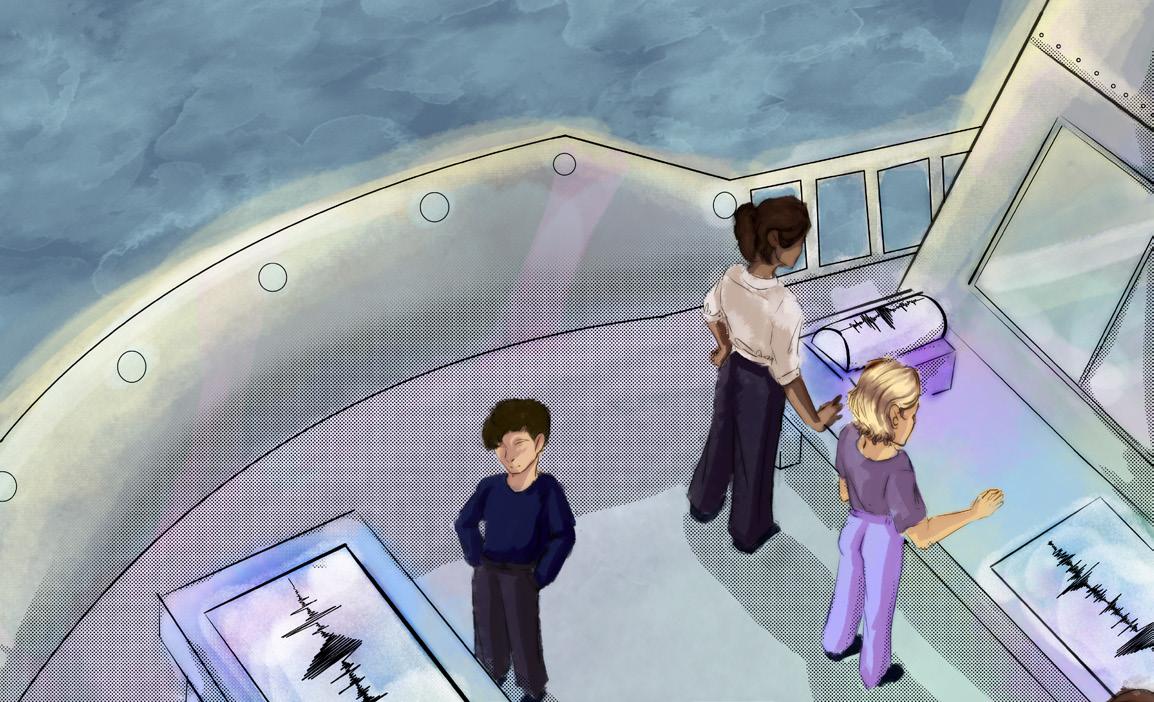
Professor of Dance Doria Charlson shared another perspective about the potentially exploitative nature of AI models like Norwood.
“AI has the potential to allow for wealthy technocrats to reap extraordinary pro t from workers whose words, ideas, voices, bodies, and images are being harvested and manipulated without adequate compensation or consent,” Charlson said via email.
!e question of whether or not AI can authentically “act” is one of extreme interest to many scholars, especially in the current context of Norwood.
“There is a common theory of performance from the scholar Richard Schechner that describes performance as ‘twice-behaved behavior,’” Charlson said. “In other words, performance is inherently something that one has done before, but in a new context. Acting, when viewed through this lens, is the product of intensive training, rehearsal, and interaction between the actor and another entity (the audience, the camera, the environment, etc).”
Charlson also noted the idea that acting requires intention. An AI actor lacks the true essence of artistry and intention that is a cornerstone of expression to the human actor.
these things be true at once?
As AI continues to make its way into creative spaces, Norwood stands as both a technical marvel and a mirror. !is creation forces us to question: if machines can imitate emotion, what becomes of artistic authenticity?
!ere is a point you reach in a lot of science where the type of mass analysis you can do with the computer becomes an invaluable tool,” Redick said, noting that the other graduate students in her cohort ended up learning coding as well. Perhaps learning coding is something to consider when building your resume for graduate school. Computer science courses can be found through UC Davis as well as various other resources.
For the large scale models Redick works with, the high-performance computing (HPC) resources on campus are necessary, and require a lot of knowledge to navigate and understand. After creating the models, data can be pulled for analysis. Programming codes help make the process more repeatable later on, and save time when running the process through several di erent models. SEISMIC on 7 AI ACTRESS FROM PAGE 4
“I think that to discount the human, organic, and embodied component of acting as an art form is problematic,” Charlson said. “One wouldn’t say that a cartoon character, like Bugs Bunny or Mickey Mouse or Spongebob is a great actor. We would acknowledge the human labor and creativity behind the animation from the voice actor, the artists who draw the form, etc. But in this same vein, AI actors are not ‘acting,’ they’re following a set of programmatic parameters in response to an input of data without any emotion, knowledge, or sensibility.”
What’s at stake here?
For both Kemp and Charlson, the debate around Norwood isn’t just about the singular digital actress, it’s about what de nes artistry. Acting, they argue, is a profoundly human exchange, rooted in vulnerability, spontaneity and the ine able connection between performer and audience.
“Actors learn to stay present,” Kemp said. “Another word for ‘present’ is to engage in deep and full-body listening. What distinguishes us is actually what binds us together.”
While Norwood’s creator Van der Velden took to Instagram on Sept. 28 to explain that the AI actress is not a replacement for human work, but a creative tool, she also stated that she wants Norwood to become “the next Scarlett Johansson or Natalie Portman,” according to Today. How can both of
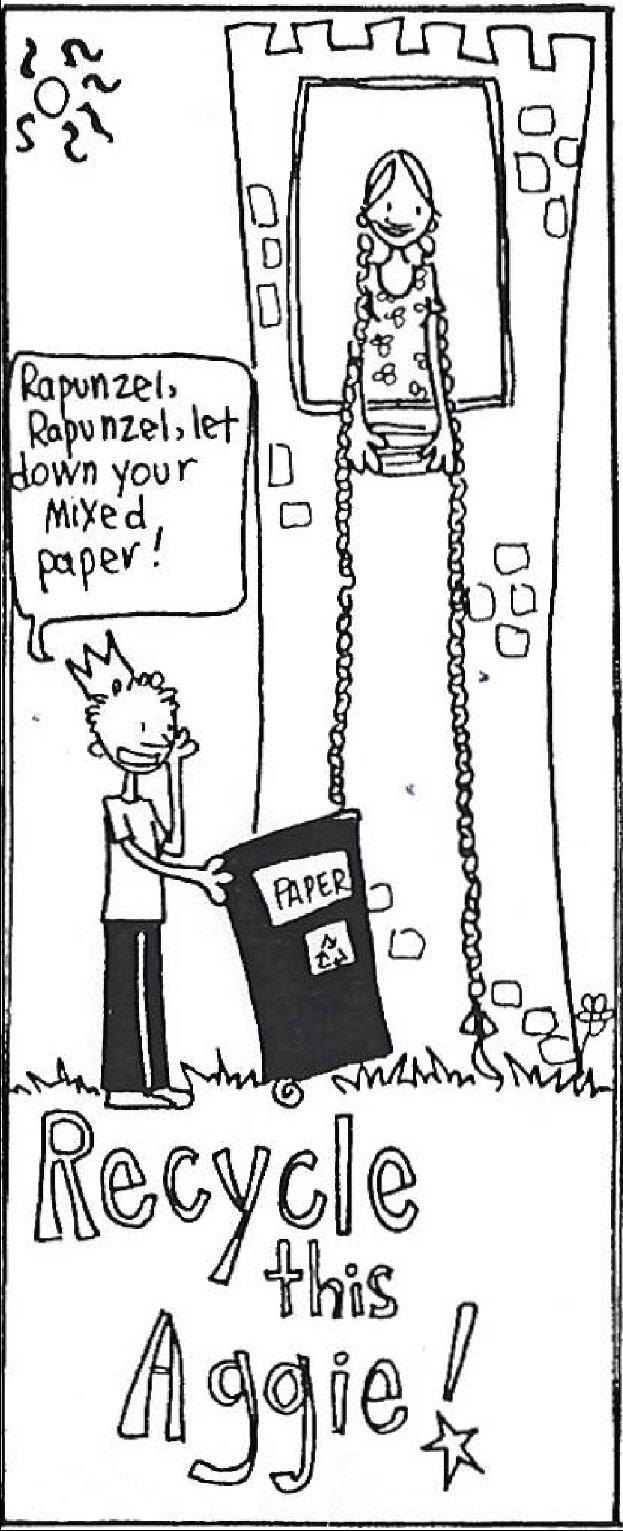
Despite
the
BY DANIELLE WIRNOWSKI sports@theaggie.org
The UC Davis Aggies’ men’s water polo team headed down to San Jose on Oct. 4 to participate in the BW Invitational, the San José State University (SJSU) State Tournament, where they went head to head against SJSU and Loyola Marymount University.
e Aggies, ready for a rematch against SJSU, went into their game with a ghting spirit.
“I want to prove [SJSU] wrong,” Brody Crouch, a fourth-year communications major, said. “I want us to come out ring.”
UC Davis’ team went on the attack from the whistle, scoring one goal within the rst four minutes of the game. Despite the goals SJSU scored, the Aggies prevented them from taking the lead. By the end of the rst quarter, the Aggies were up 3-2. Davis’ players continued this attack well into the second quarter, only allowing SJSU to score two additional goals while the Aggies were able to score three. By the start of the second half, the Aggies had earned a 6-4 lead.
Thomas Marr, a second-year managerial economics major, and omas Kiesling, a third-year economics major, helped their teammates remain in the lead heading into the second half, scoring two goals each.
e Aggies held on to their lead through the third quarter and up until the midway point in the fourth quarter.
At the beginning of the fourth, SJSU went on a scoring drive, scoring two goals within the rst two minutes.
is put them in the lead, 8-7, with six minutes left in the match.
In the last three minutes of the game, the Aggies turned to Crouch, resulting in a tied score at 8-8. In the last 20 seconds, SJSU got past the Aggies’ defense and managed to score one last goal, giving them the victory.
Despite UC Davis’ loss, the players showed signi cant improvements in multiple areas in their play and narrowly missed a victory.
“You either win or you learn,” Crouch said of his water polo coach’s philosophy.
From the Aggies’ match against SJSU on Sept. 6 to this match, it is apparent they have learned from their previous match and made signi cant improvements.
Crouch described his mindset and remaining positive after losses.
“Knowing that if we lose, then we lose, [it goes] on our record but doesn’t really matter. Who cares?” Crouch said.
“You have to have a gold sh mindset about it. You have to just be ready to move on.”
During the same match-up in September, the Aggies only managed four steals — in this match, they had 23 steals. UC Davis’ team also took more shots in this match than in the previous, taking a total of 37 shots versus 35.
Baxter Chelsom, a third-year psychology major, increased the number of saves he made as a goalkeeper, going from eight to nine. Additionally, the Aggies decreased the number of penalties they received, moving from 13 to nine.
Improvements were made in both offensive and defensive strategies, resulting in a close score for the Oct. 4
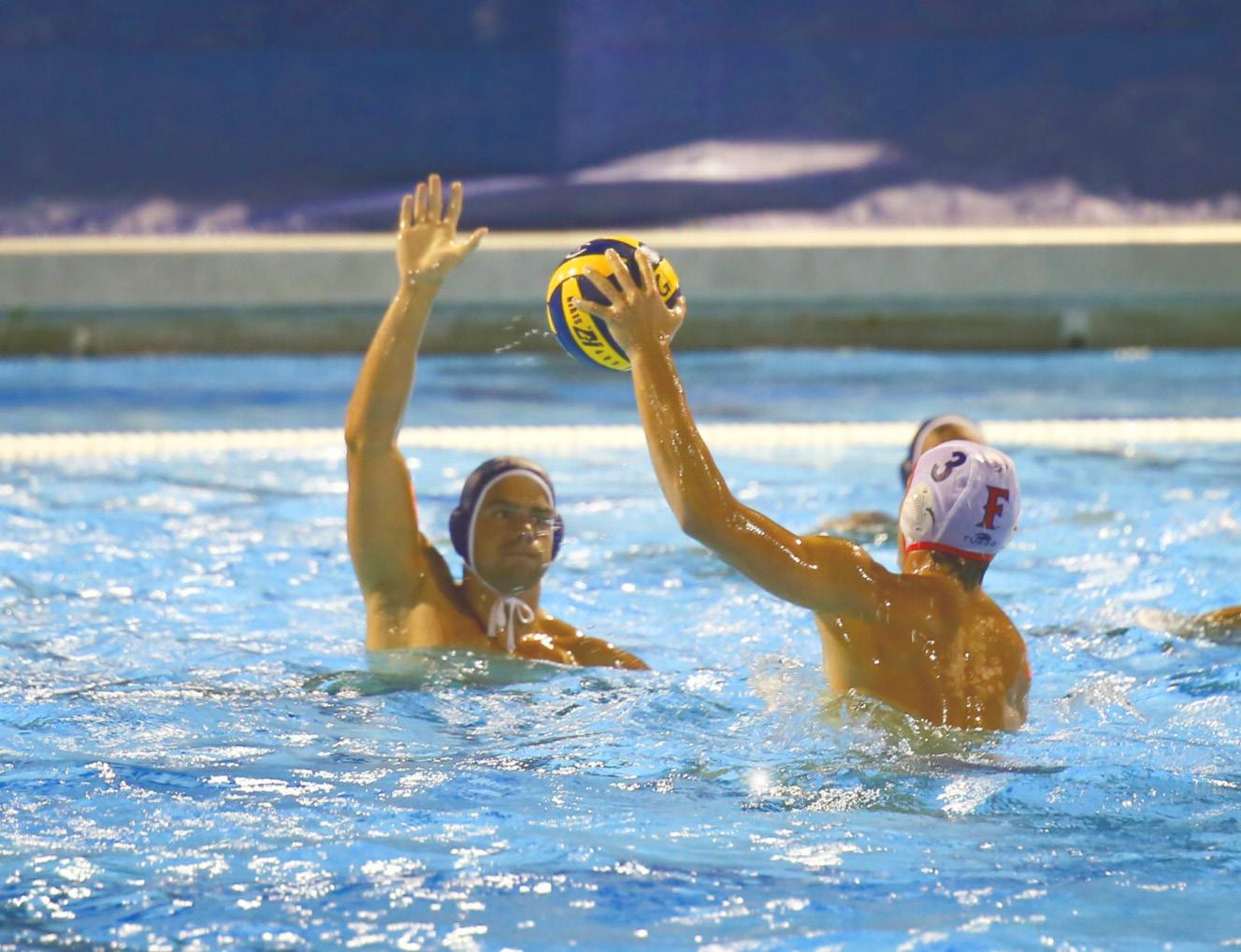
match. ese improvements were made possible due to the team atmosphere and leadership on the men’s water polo roster, which fosters an environment of growth and support, according to Crouch.
“ ese guys are my family,” Crouch said. “We really rely on each other for
everything outside of classes [and] outside of practices. We spend time together; we live together.” is leadership and friendship, as noted by Crouch, encourages team bonding and cultivates cooperation and communication within the team in and out of the water.
e Aggies hop back into the water on Oct. 10 against the University of California, Irvine. Following this match-up, Davis’ team will return home on Oct. 17 to play against California State University, Fullerton, a game that will feature a cowbell giveaway and a faculty and sta appreciation.
The 3-1 victory over UC Irvine marks the Aggies’ fifth consecutive win


Currently ranked sixth in the Big West Conference, UC Davis had yet another at-home victory this season. Winning with a final score of 45-24 against Northern Arizona University, the Aggies have been a force to be reckoned with so far this season. With another 300-yard passing performance by quarterback and second-year human development major Caden Pinnick, the Aggies scored five touchdowns. The defense also proved to be as impressive as the offense, with nine tackles alone from second-year sociology-organizational studies major Jackson Sievers and six tackles from graduate student Jacob Psyk. It was a thrilling match for the Aggies and fans alike.

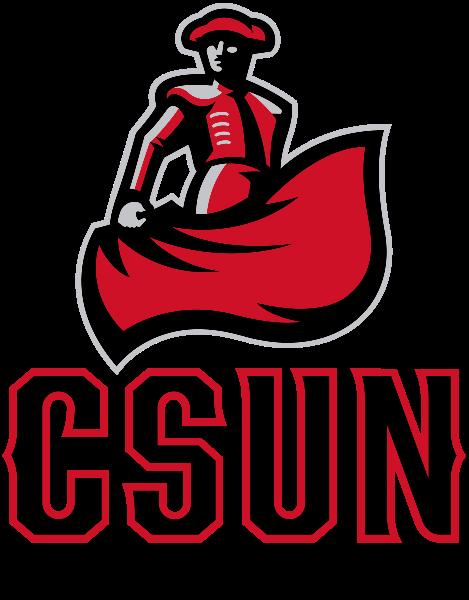
Finally breaking their tough streak of ties and losses, the UC Davis men’s soccer team secured its first conference win of the season. Fourth-year neurobiology, physiology and behavior (NPB) major Gabriel Haggerty scored his first career goal in the second half of the match, pushing UC Davis to an Aggie win.


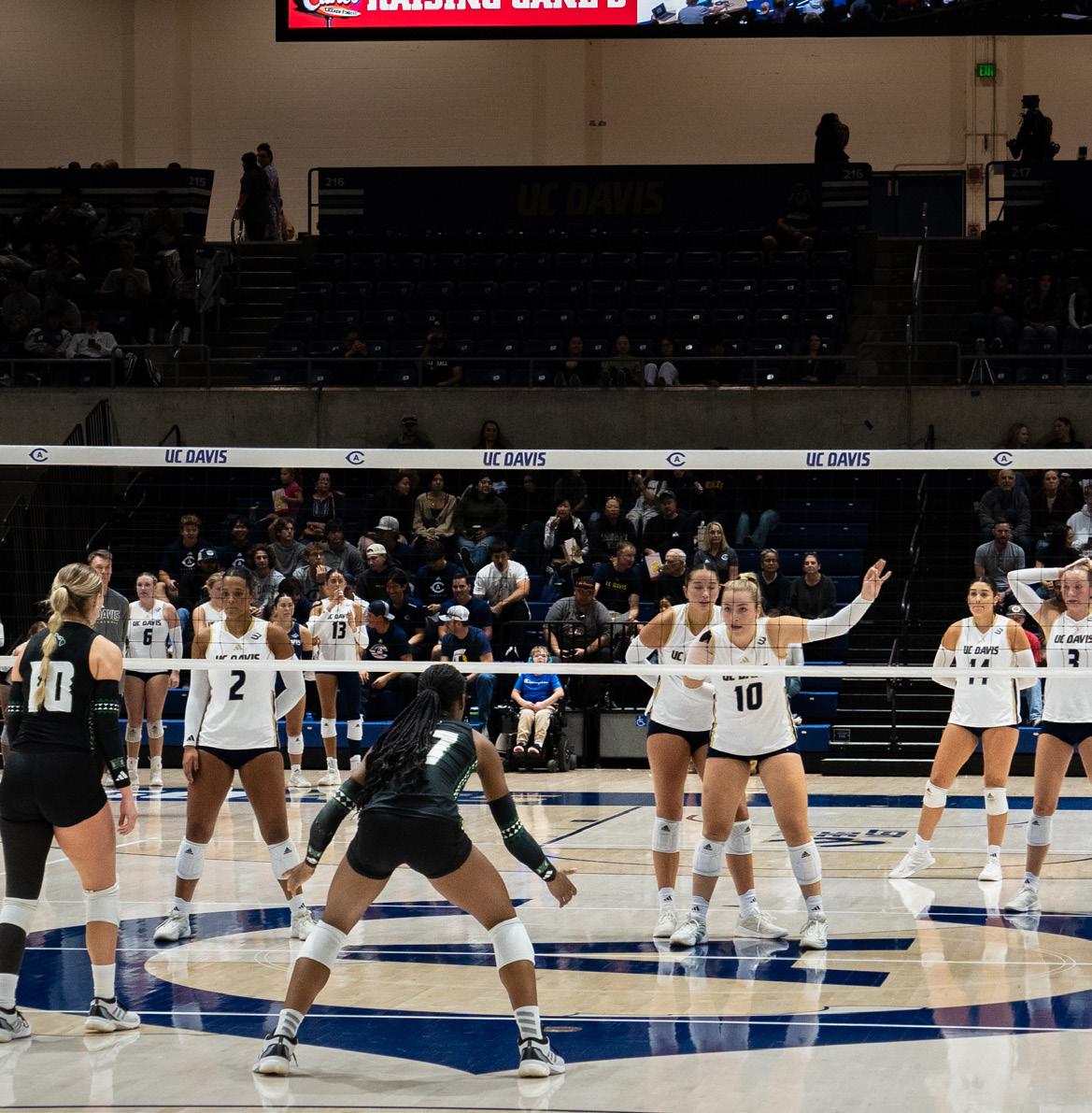
BY COLINA HARVEY sports@theaggie.org
On Oct. 4, UC Davis Women’s Volleyball hosted University of California, Irvine (UCI) in the second game of a four-game home stand. e Aggies defeated the UCI Anteaters 3-1, marking their fth win in a row. e win also brought the team’s conference record to 4-0. In early-season invitational tournaments and non-conference games, the team had mixed results, with a non-conference record of 4-4. However, since starting conference play, they have racked up wins against UC Riverside, the University of Hawai’i, California State University Fullerton, and UCI.
e rst set of the Aggies’ matchup against UCI started with both teams trading points until the Anteaters scored ve straight times, four of which were o of UC Davis’ errors. is took the score to 12-6, giving UCI an edge. While the Anteaters were able to maintain their lead for much of the rst set, the Aggies crept closer and closer until senior setter Haden Bones, a fourth-year cognitive science major, tied the game up at 23-23. An opponent block took the score to 24-23, creating a set point for UCI. A kill by outside hitter Jade Light, a fourth-year aeronautical engineering major, tied the game back up, until an error by the Aggies created another set point for UCI. However, the Anteaters could not capitalize on this set point, as the Aggies scored three more points to come from behind and take the rst set. Middle blocker Ally Chandler, a third-year human development major, stood out early with six kills in the rst set alone.
Although the second set was even at the start, UCI quickly pulled ahead and created separation, forming their largest lead of the game and leading the Aggies 18-10. Nonetheless, the Aggies crept back, managing to close the gap to four points. However, the Anteaters had created too big a lead for the Aggies
to overcome. UCI equalized, winning the set 25-18.
In the third set, the tables turned, and it was the Aggies who built up an early lead. ey got o to a quick start, leading Irvine 6-1 before prompting UCI to take a timeout. en, a kill by outside hitter Brooke Hibino, a thirdyear managerial economics major, was successfully challenged by UCI and overturned, slowing the Aggies’ momentum.
UCI started to close the gap, turning the Davis lead — which had been seven points before the challenge — down to three. However, the Aggies bounced back with a strong set of kills that put them ahead by nine points. e Aggies were able to maintain their lead and close out the set with a score of 25-13. e fourth set stayed extremely tight throughout, with neither team able to break away. at was until near the end of the set, when Davis started to creep away. Kills from Hibino and Breeze Czapinski, third-year international relations and psychology major, brought the score to 23-19, the largest lead of the set.
e Aggies kept the small lead until the end of the game, winning the set 25-21 to remain undefeated in Big West play. Chandler led the team with 14 kills, while Light and Czapinski had 13 each. Libero Ximena Cordero Barr, a secondyear landscape architecture major, showed out defensively, recording 35 digs. In last season’s Big West tournament, the Aggies comfortably clinched a position as the third seed out of six qualifying teams. While they were able to get past the sixth seed, UCI, they fell to the second seed in the quarter nal, University of Hawai’i, in a riveting ve-setter.
eir strong performance in this season’s games so far shows that this year’s squad has the potential to make a deep run in the Big West tournament, and potentially reach the national tournament.